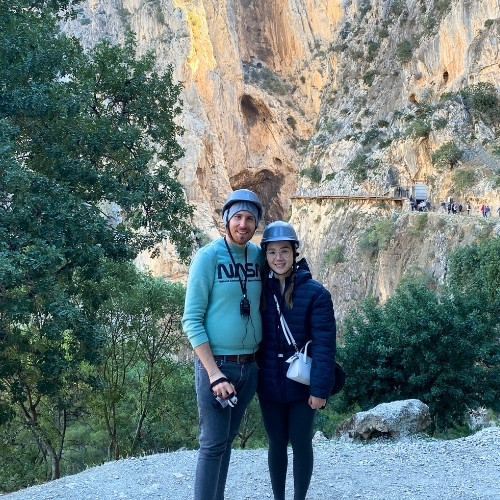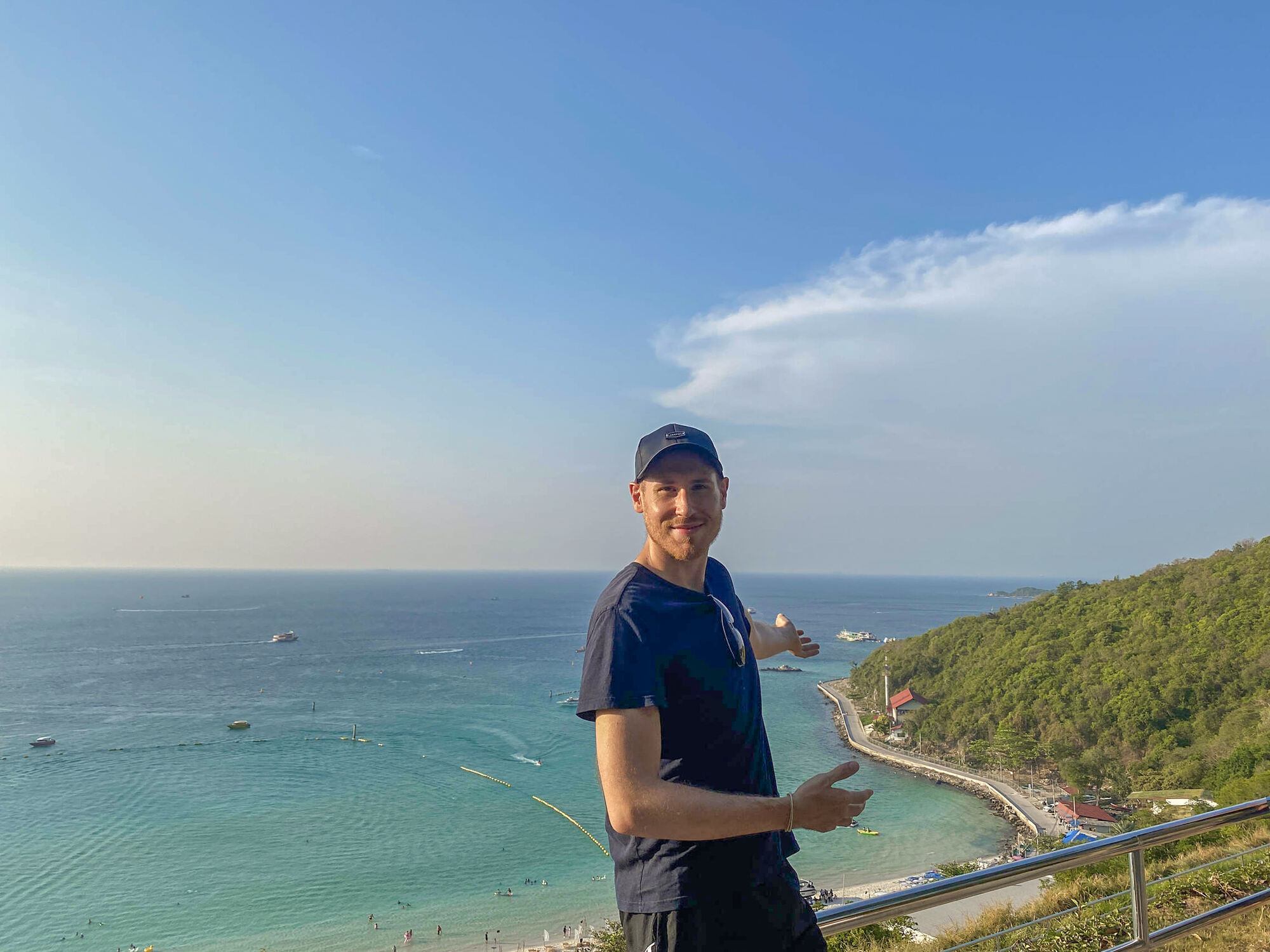Southern Spain is an incredible part of the country, and there are countless things to see and do, and visiting some of the white villages in Andalucia is one you just can’t skip!
Discover villages where time seems to stand still, and the traditional Andalusian way of life flourishes. Whether you’re a history lover, travel for photos, or just want a cool, relaxing break from the bigger cities, the white villages of Andalucia are a great option.
This guide is your comprehensive passport to exploring these picturesque locales, each telling its own unique story against a backdrop of rolling hills, ancient fortresses, and blue skies.
From the cobblestone streets of Ronda to the cliffside homes of Setenil de las Bodegas, we’ll go through the best of them, which are all around Andalusia for added convenience. Let’s get started, this will be a long guide!
Note that White Villages in Spanish is Pueblos Blancos, and I’ll be interchanging both terms throughout this article.
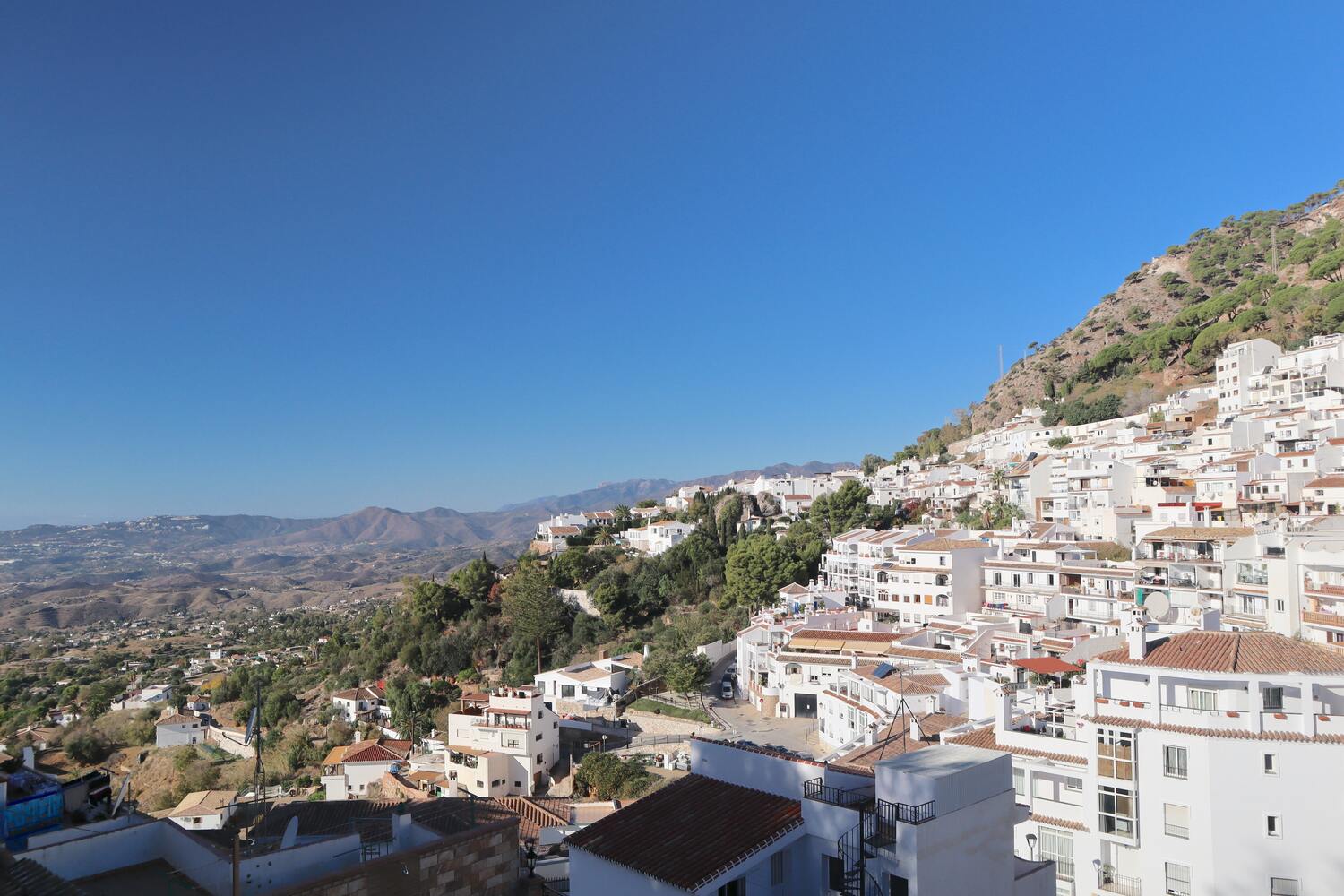
White Villages in Andalucia – Overview
I understand you may not have the time to go through the whole list (but I really recommend you do!) so here’s a quick list of my favorite white villages near Malaga and beyond.
- Ronda Pueblo
- Mijas Pueblo
- Frigiliana Pueblo
- Setenil de las Bodegas
- Arcos de la Frontera
Of course, there are more, so keep reading to know all of them.
What are the White Villages of Andalucia?
The White Villages of Andalusia, known as “Pueblos Blancos,” are a collection of picturesque towns famed for their distinctive white-plastered buildings nestled in the southern Spanish region of Andalusia.
These villages are renowned for their historical significance, beautiful landscapes, and Moorish heritage. They offer a glimpse into traditional Spanish life, with narrow winding streets, flowering balconies, and stunning natural surroundings.
How Many White Villages in Andalusia Are There?
While there is no official count, it’s known that the provinces of Málaga and Cádiz alone boast around 20 Pueblos Blancos each.
However, when considering the entirety of Andalusia, the number significantly increases, encompassing many more villages that exhibit the same charming characteristics.
For those interested in exploring these iconic destinations, this list will highlight 30 of the best white towns, and I’ll categorize them by location, so you know where to start when planning your Southern Spain itinerary.
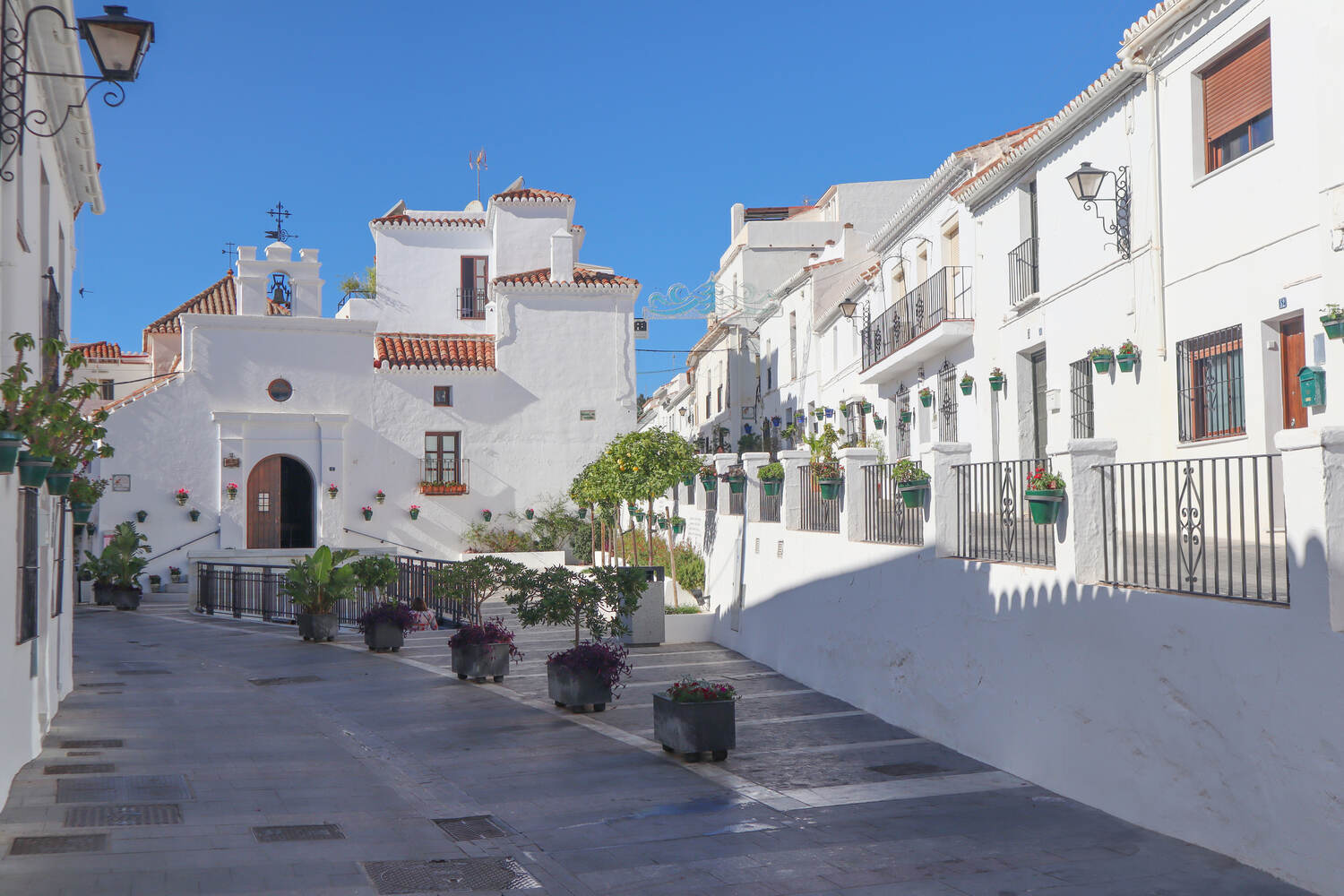
Are the White Villages of Andalusia Worth Visiting?
Absolutely, the White Villages of Andalusia are among the most captivating destinations in Spain, offering more than just scenic beauty.
They are steeped in history and culture, showcasing the region’s Arab past, Christian reconquest, and rich Andalusian traditions. I honestly can’t imagine planning a trip to Southern Spain without visiting the White Villages of Andalucia.
Best Time to Visit the White Villages
The best time to visit the Pueblos Blancos of Andalusia is during the spring (March to June) or autumn (September to November) months.
These periods offer pleasant weather, with mild temperatures and fewer crowds, allowing for a more enjoyable exploration of the villages’ narrow streets.
Spring brings the countryside to life with blooming flowers, while autumn offers the chance to partake in local harvest festivals, which adds a layer of uniqueness.
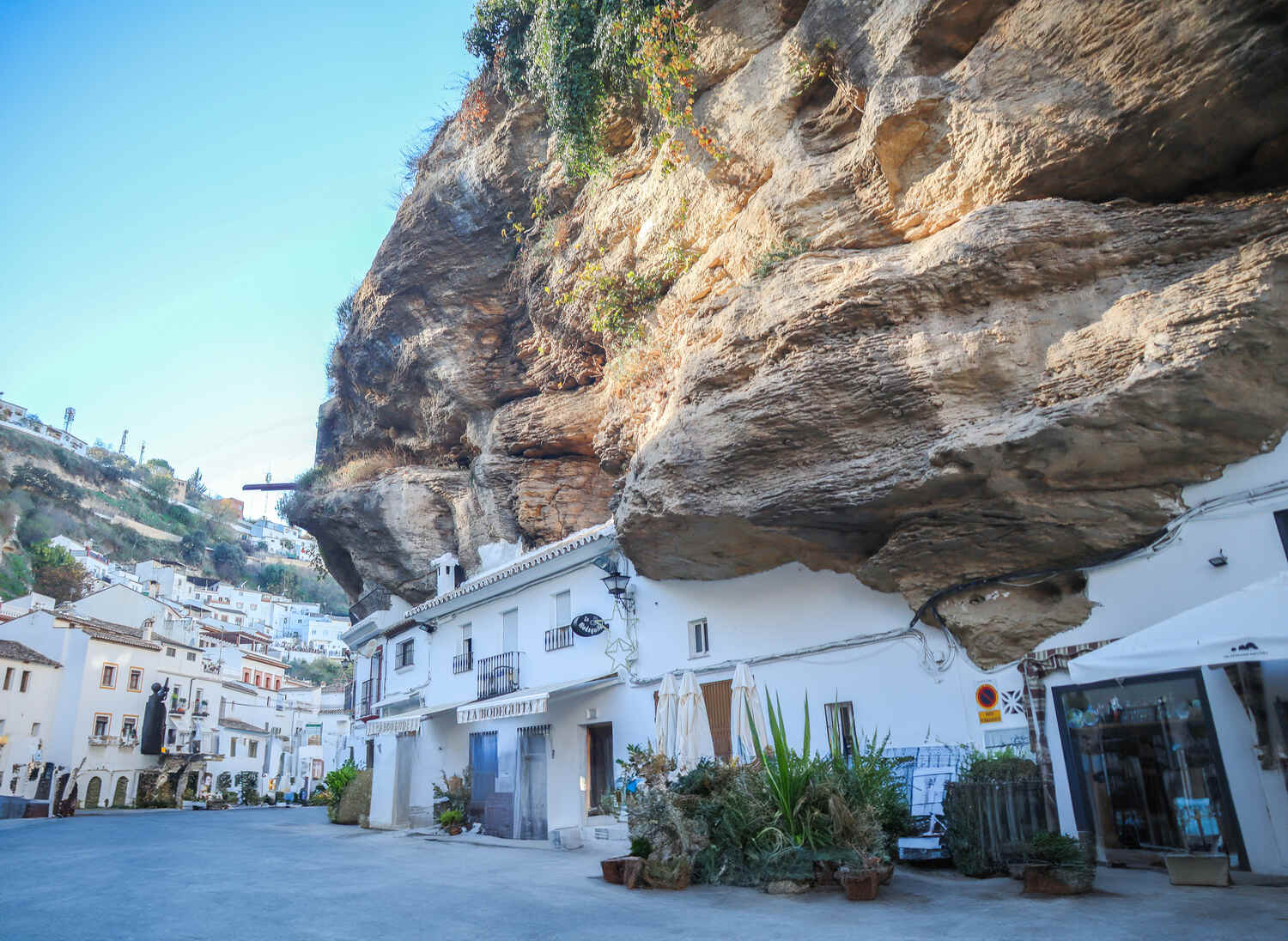
30 Best White Villages in Andalucia
Now that you know the essentials, let’s go through all the white villages in Andalusia that are worth a visit. Of course, you won’t have to see all of them on your road trip to Spain, but it’s a good list to start planning.
In this guide, I’ve separated the white villages of Andalusia into different sections, near Malaga, Cadiz, or Cordoba, Granada, and Jaen, which are the bigger cities near these white-washed towns.
White Villages Near Malaga
Explore the sun-kissed villages near Malaga, where the sea’s breeze meets the mountains. Picture wandering through streets lined with flowers, sipping local wine under the Andalusian sky.
These spots are just a short trip from Malaga, perfect for experiencing Spain’s laid-back village life and breathtaking landscapes.
Also, the area near Malaga is the one with the most Pueblos Blancos, and there are 14 only in this section!
Antequera
Antequera is a hidden gem in the heart of Andalusia, about 45 minutes from Malaga. It’s like stepping into a time machine, with history oozing from every corner.
Here, you can explore the Alcazaba of Antequera, a Moorish fortress with breathtaking views, or get lost in the Dolmens of Antequera, ancient megalithic tombs that are a UNESCO World Heritage site.
Don’t miss the El Torcal Natural Park, famous for its otherworldly limestone rock formations.
A fun fact: Antequera is known as the “heart of Andalusia” due to its central location. It’s the perfect spot for history and nature lovers, and it’s hard not to be impressed when coming.
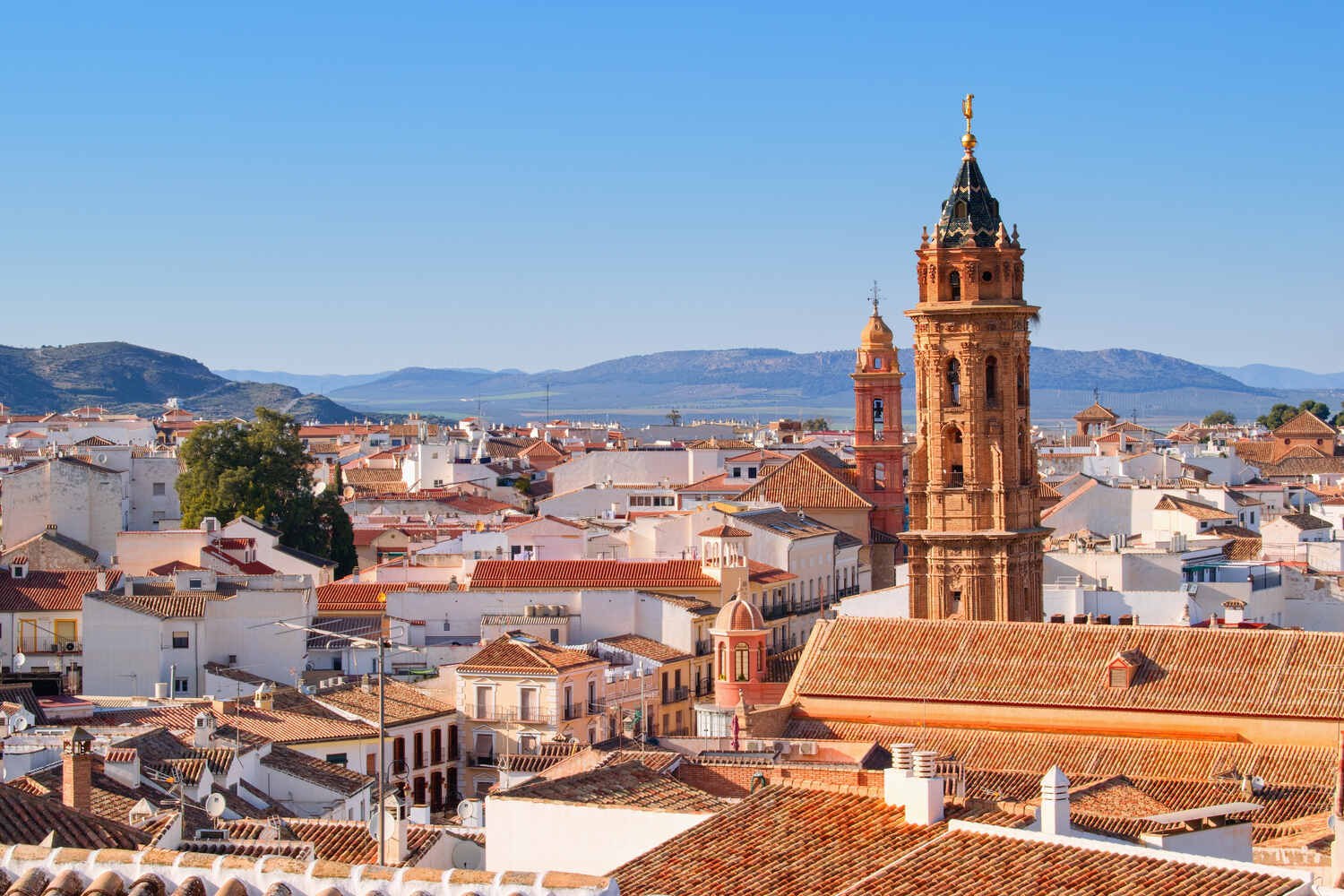
Benalmadena Pueblo
Benalmadena Pueblo, nestled about 20 minutes from Malaga, offers a charming escape from the vibrant cities of the coast. Wander through its whitewashed streets and soak in the authentic Andalusian atmosphere.
Visit the Castillo de Colomares, a fairy-tale-like castle dedicated to Christopher Columbus and the discovery of America. The Butterfly Park of Benalmadena is another must-see, hosting over 1,500 exotic butterflies.
For stunning sea views, head to the Stupa of Enlightenment, the largest Buddhist stupa in Europe. Benalmadena Pueblo is a peaceful retreat with a mix of cultural and natural attractions.
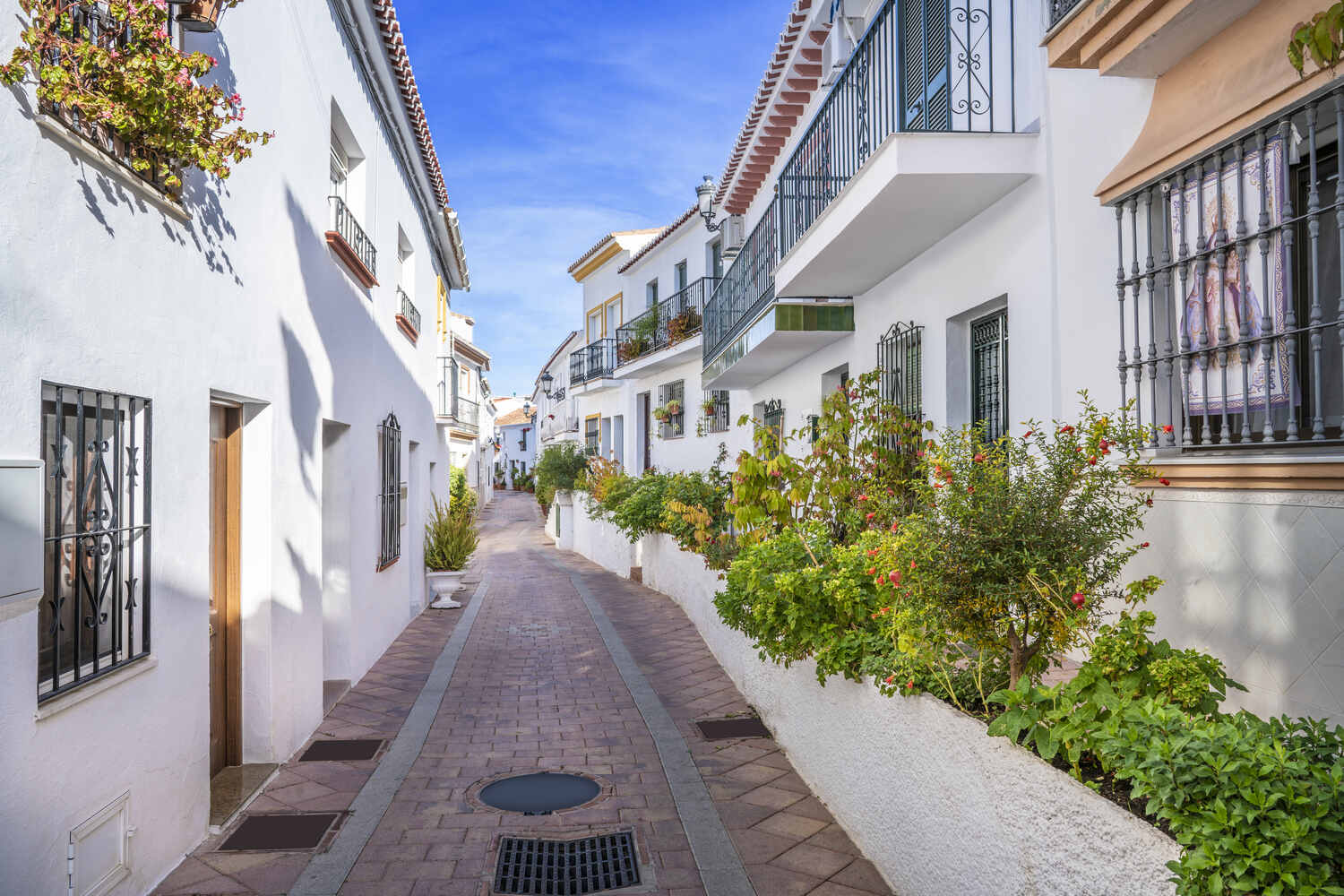
Benahavís
Just a stone’s throw away from Marbella, about 20 minutes, lies Benahavís, a culinary haven tucked in the mountains.
Famous for its gourmet dining scene, it’s a foodie’s paradise with more restaurants per capita than anywhere else in Andalusia. After indulging in local delicacies, burn off those calories by exploring the nearby hiking trails, such as the Guadalmina River gorge.
If you like Golf, you’ll find your happiness here, and will find several top-tier courses surrounding the village. Benahavís is also home to a rich Moorish history, evident in its architecture and layout. It’s the perfect blend of natural beauty, gastronomy, and history.
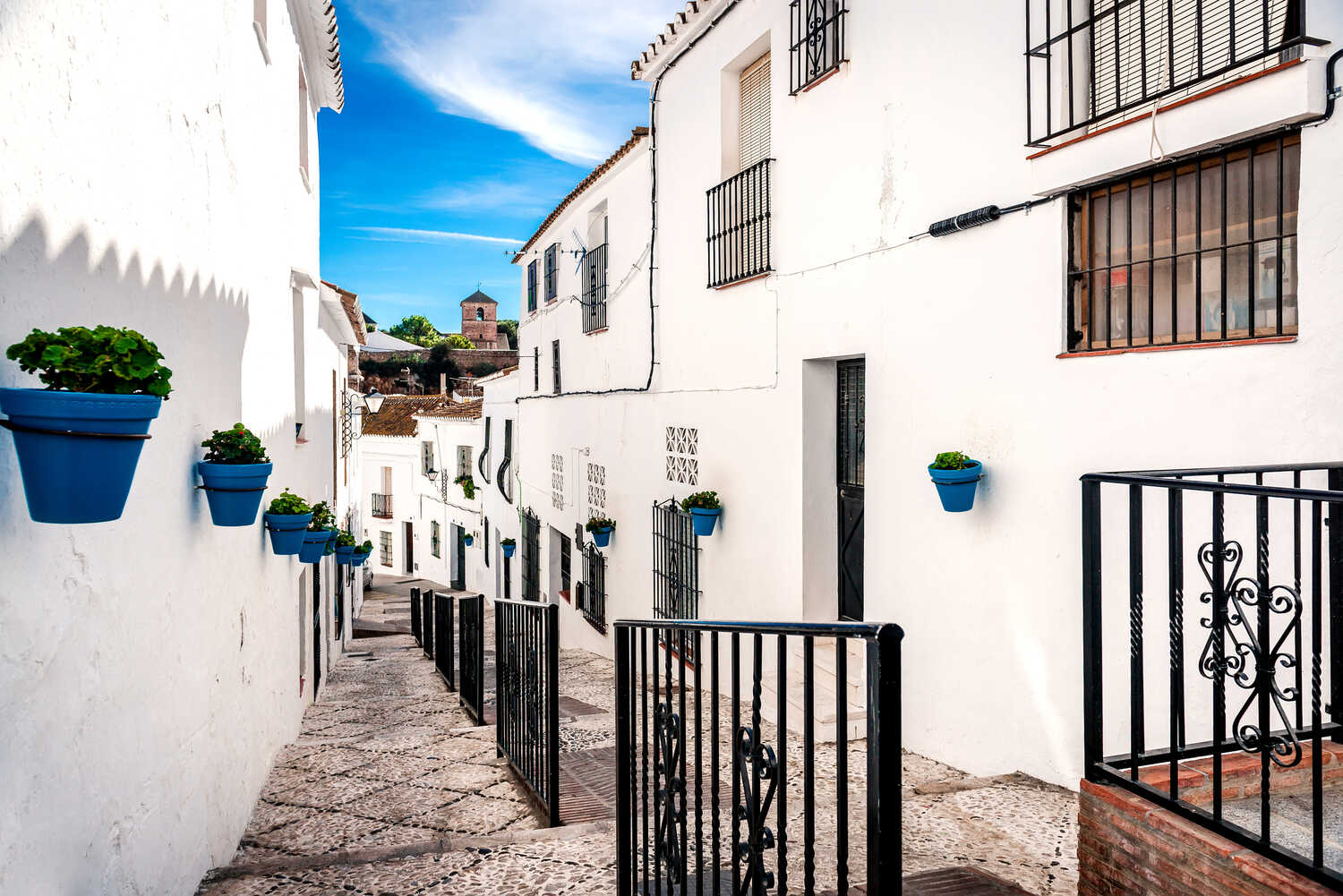
Casares
Casares, an hour from both Malaga and Gibraltar, is postcard-perfect with its cliff-hanging houses. This village offers breathtaking views at every turn, especially from the ruins of the Moorish castle at its peak.
Dive into local history at the Casa Natal de Blas Infante, dedicated to the “father of Andalusian nationalism.” For nature lovers, the Sierra Bermeja park offers excellent hiking opportunities
A little-known fact: Casares is said to resemble a sugar cube pile, a sight that’s truly magical at sunset. It’s an idyllic spot for history buffs and adventure seekers.
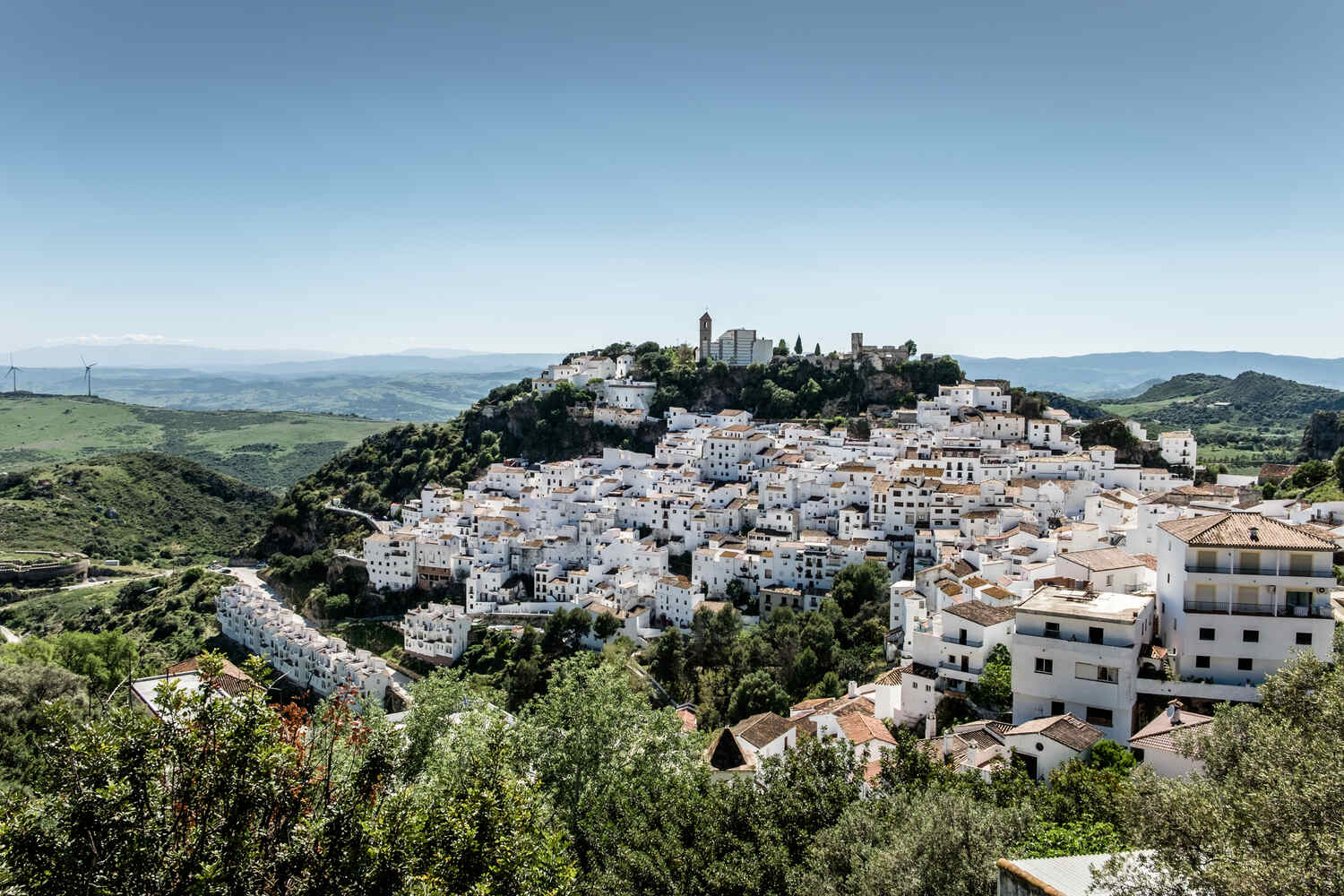
Estepona
Estepona, located about an hour from Malaga, is the garden of the Costa del Sol. Stroll through the Orchid House, a botanical garden featuring over 5,000 plant species and breathtaking orchid displays.
The old town is a maze of vibrant flower-filled streets leading to quaint plazas. Don’t miss the chance to walk the mural route, showcasing over 50 stunning pieces of street art
Estepona is also home to one of the longest beaches in the Costa del Sol, perfect for sun-seekers.
Lastly, Estepona maintains over 100 painted murals that transform the city into an open-air museum, and that will only make your visit more unique!
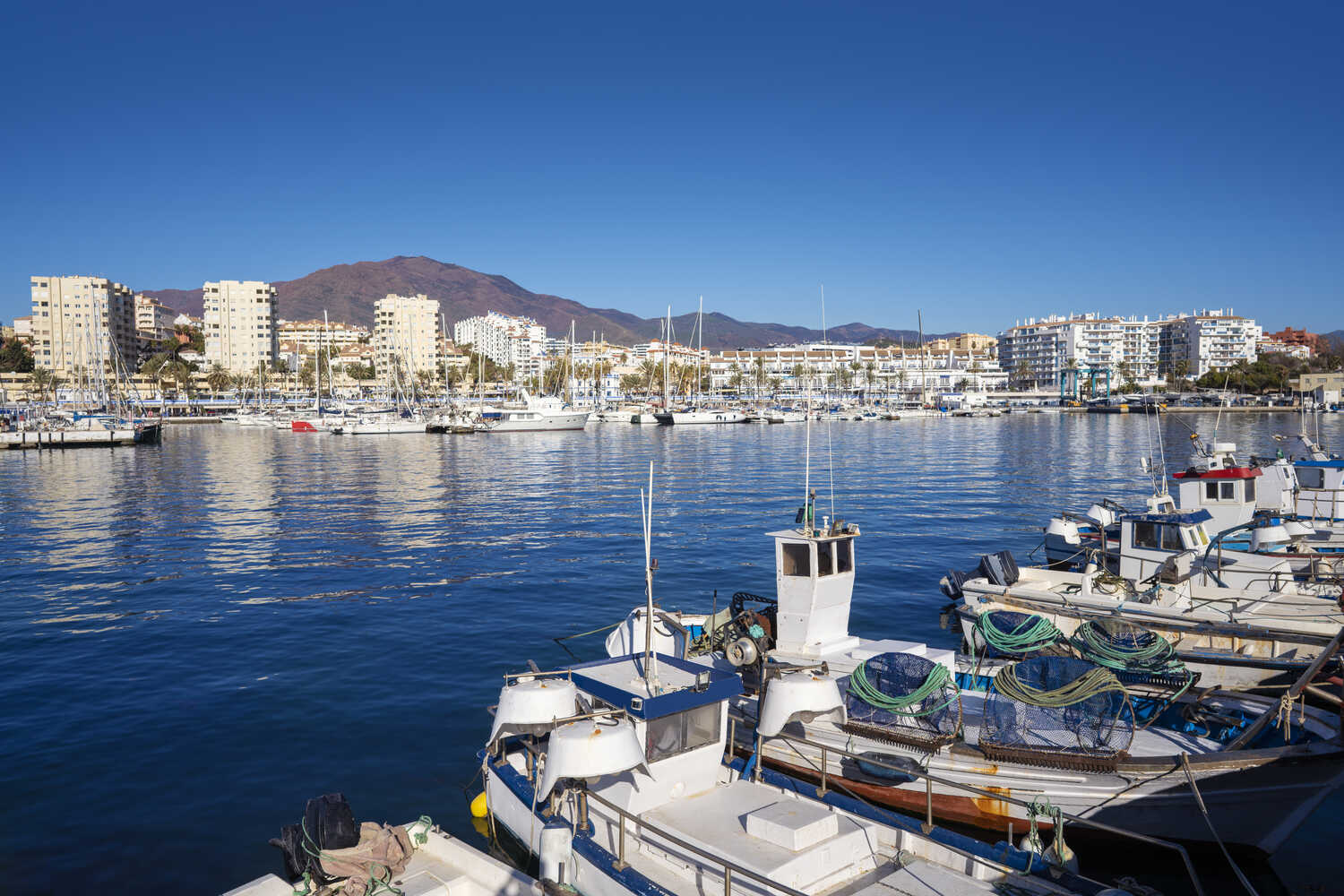
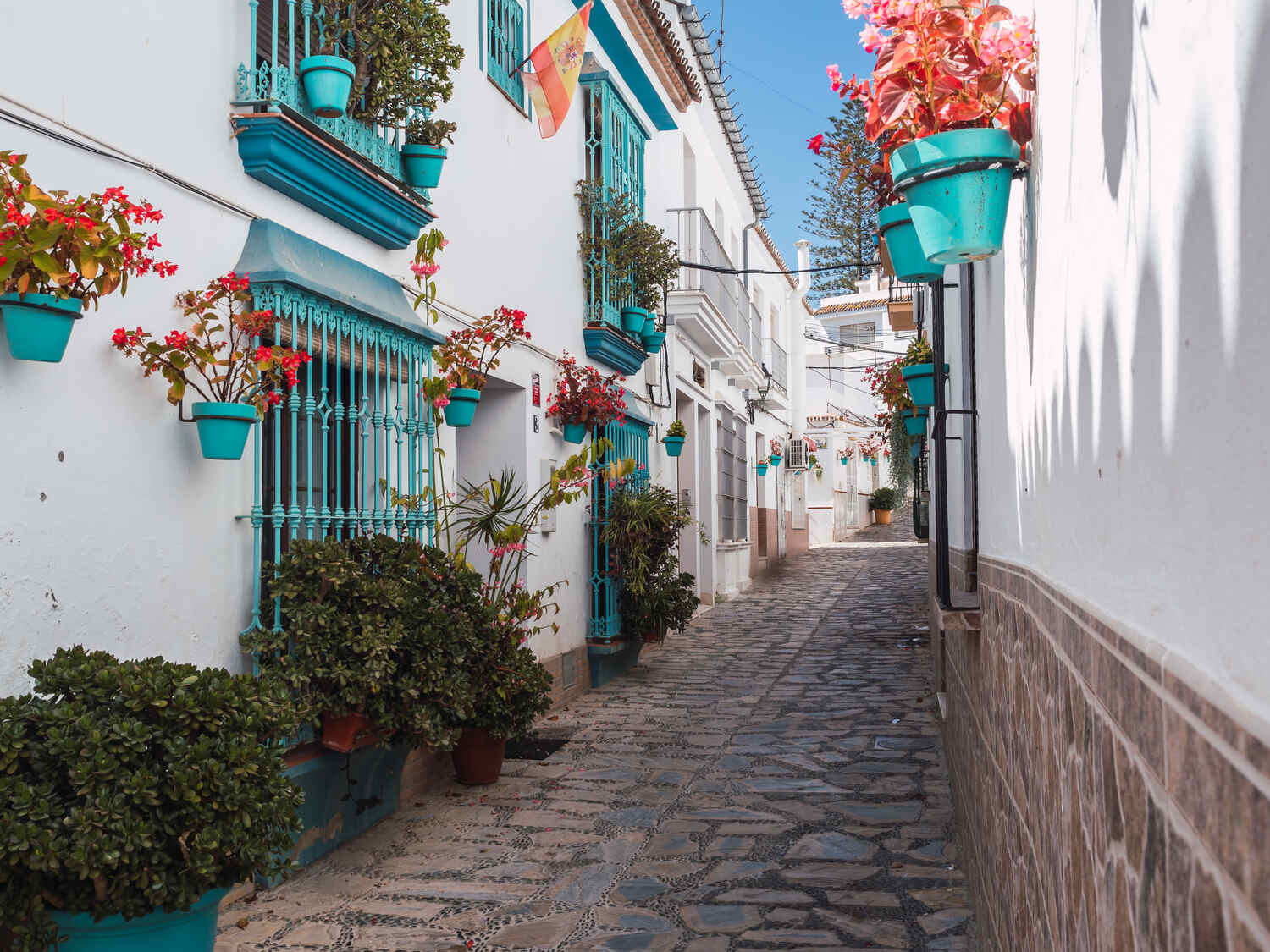
Frigiliana
Frigiliana, about a 15-minute drive from Nerja or an hour from Malaga, is crowned as one of Spain’s most beautiful villages. Its cobblestone streets and Moorish past make it a historical treasure.
Check out the old quarter, a labyrinth of narrow streets with hidden courtyards. The Archaeological Museum offers insight into the area’s rich history.
Don’t miss the local craft shops selling everything from pottery to handmade soaps. A hike along the River Higueron in the nearby natural park offers stunning vistas.
Also, it’s worth noting that Frigiliana hosts an annual three cultures festival, celebrating its Christian, Muslim, and Jewish heritage, and I just think it’s very nice to see some peaceful events in the world we live in now.
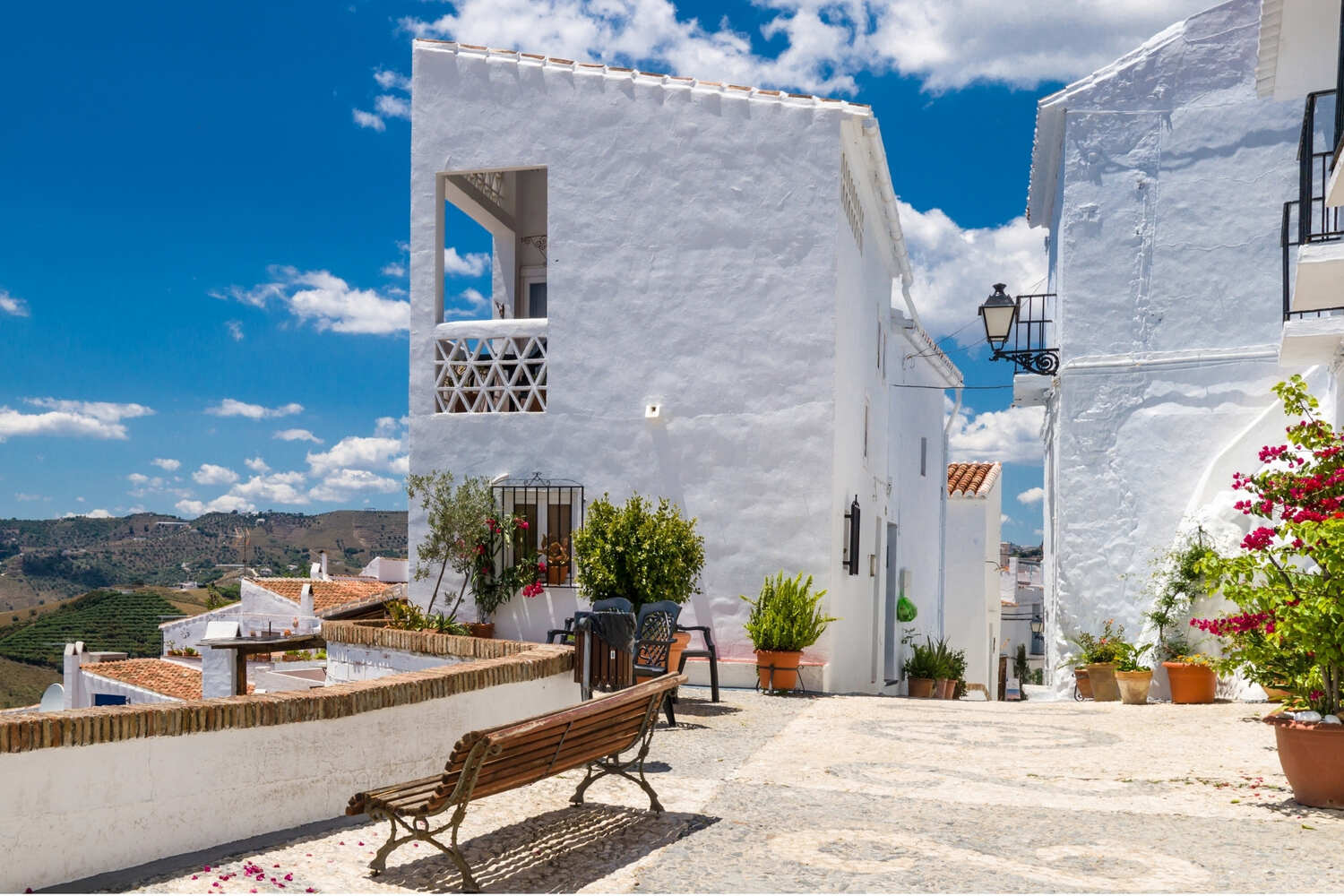
Istan
Just a 20-minute drive from Marbella, Istan sits near the Sierra de las Nieves Natural Park. It’s a paradise for nature lovers, offering numerous hiking and mountain biking trails.
The village is known for its fresh spring water fountains scattered throughout. Visit the Eco-Museum to learn about local water systems and the area’s ecology.
The Mirador del Tajo Banderas provides panoramic views of the valley and reservoir. Istan is a peaceful retreat from the coastal buzz, offering a slice of rural Andalusian life.
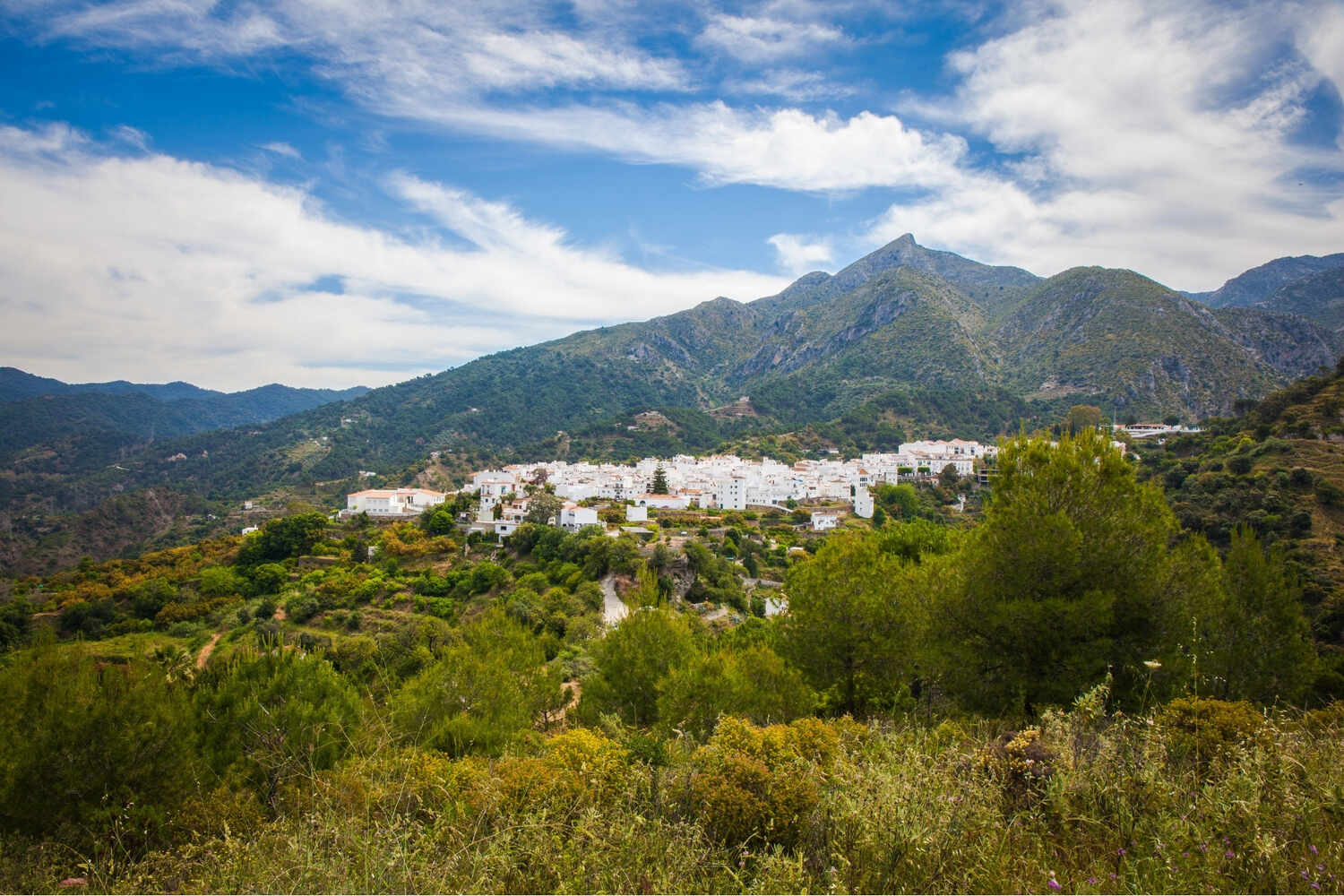
Mijas Pueblo
Mijas Pueblo is known for its unique blend of traditional Andalusian culture and modern amenities, perched in the mountains, and is about a 30-minute drive from Malaga. And yes, it’s one of my personal favorite white villages in Andalucia!
This village combines traditional charm with stunning Mediterranean views. Wander through the white-washed streets, visit the miniature donkey taxis, or explore the local craft shops.
The Ermita de la Virgen de la Peña, carved into the rock, is a must-see. For breathtaking views, check out the Mirador del Compás. Mijas is also home to the only square bullring in Spain.
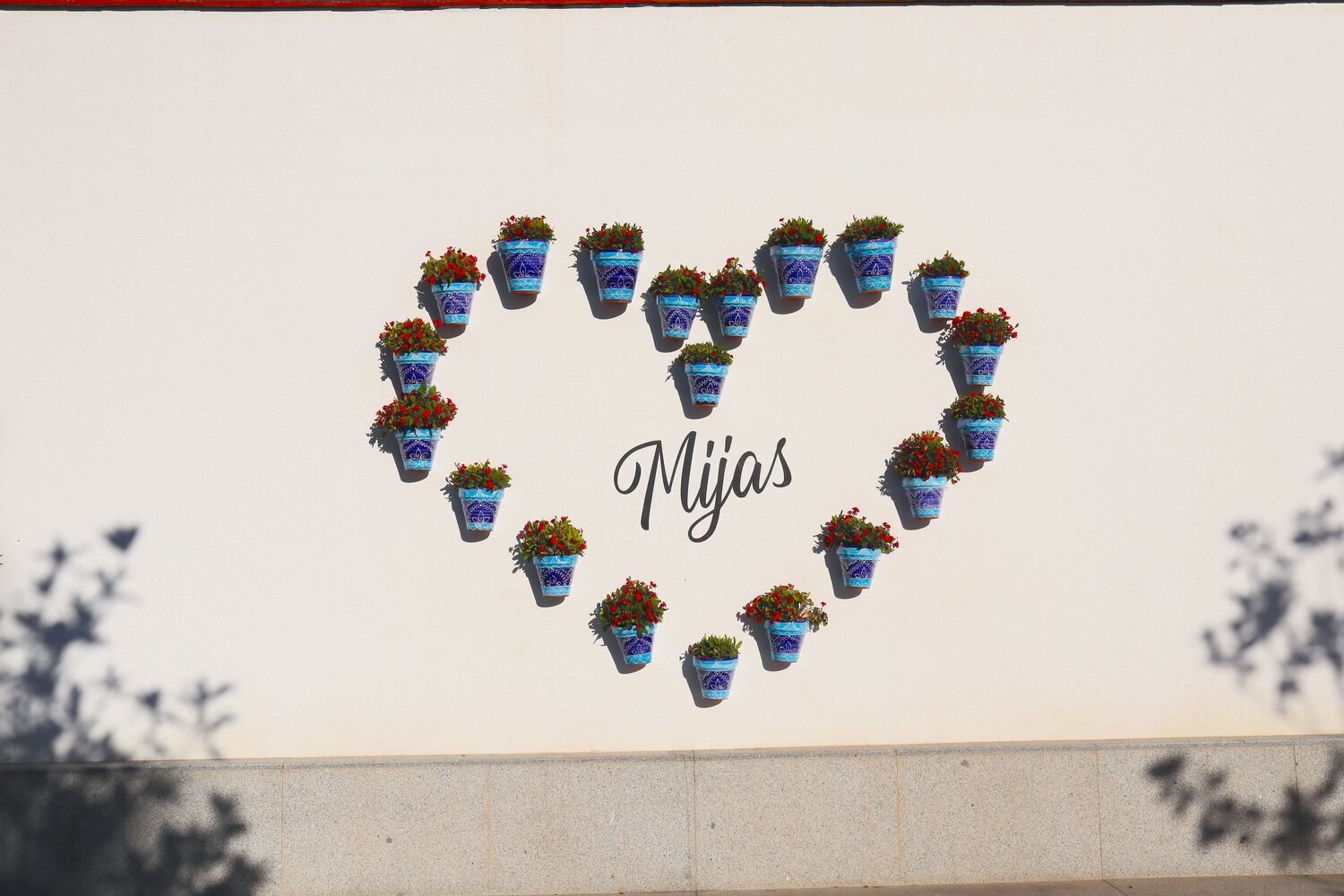
Want to know more?
Check out this guide about
the best attractions in Mijas.
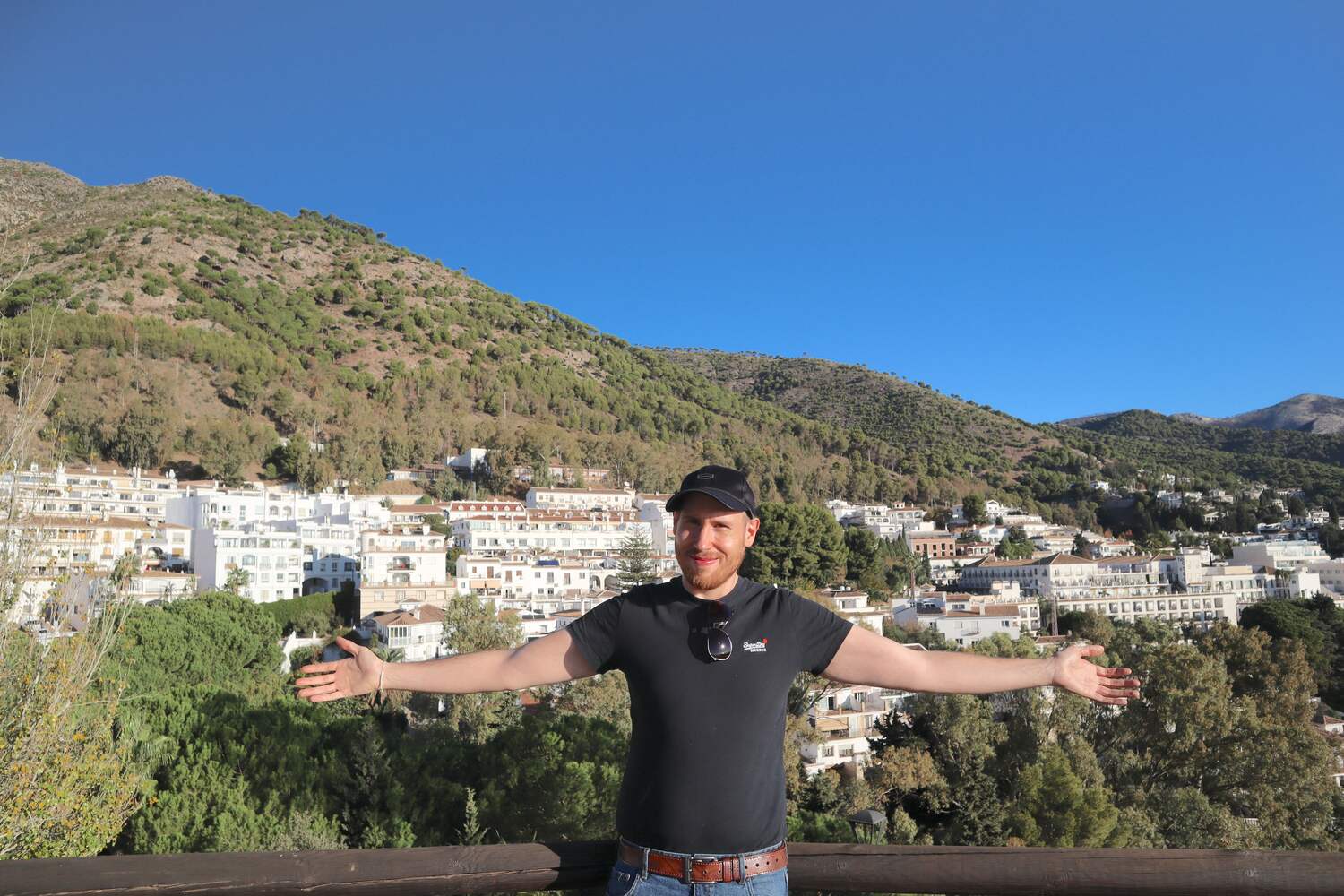
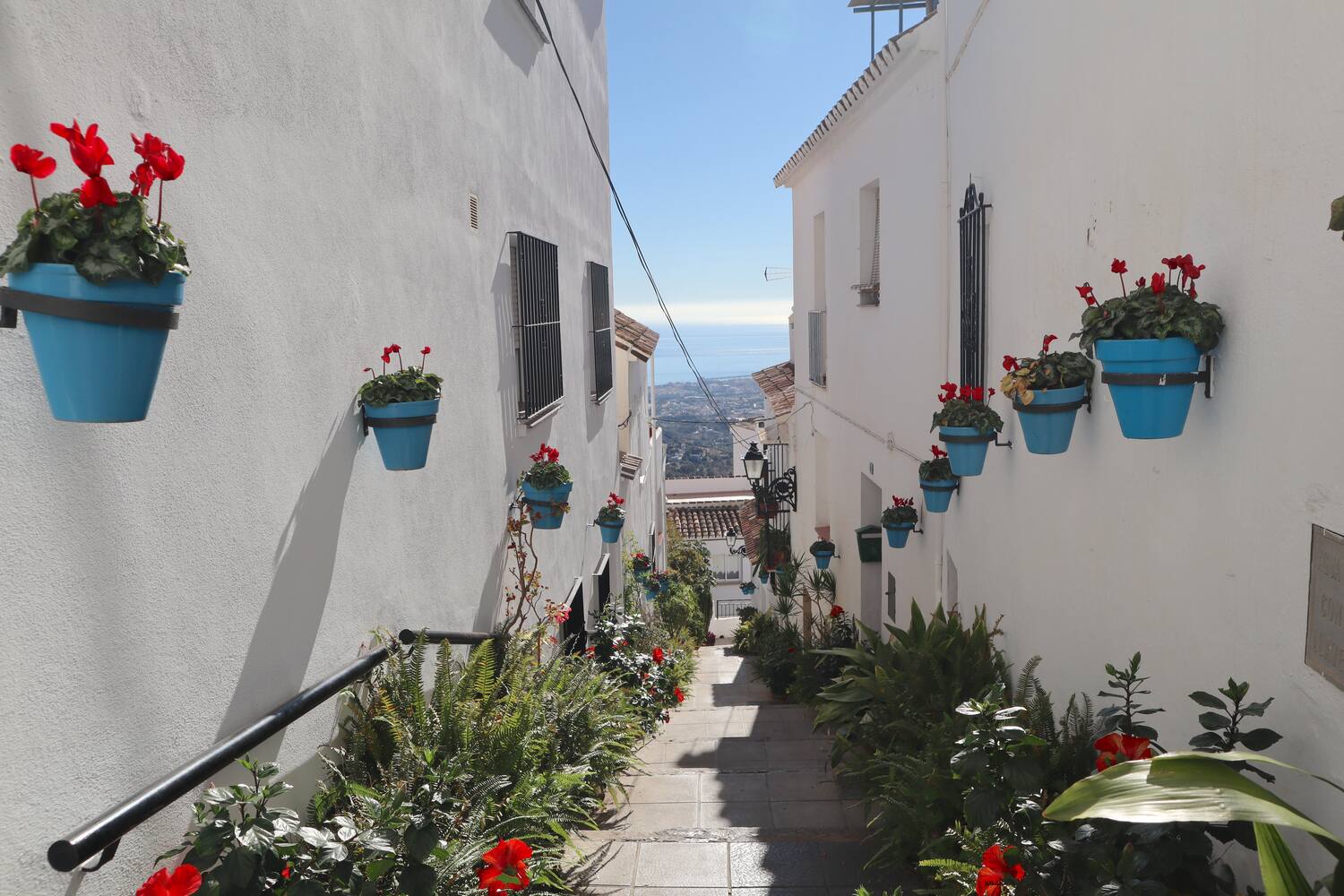
Monda
Monda is an hour away from Malaga, nestled in the mountains. It’s famous for the Castillo de Monda, now a hotel but open for visits and dining.
The village offers a genuine slice of Andalusian life, with fewer tourists and a relaxed pace. Hike up to the Al-Mundat fort ruins for some history and great views.
The local olive oil mill, Molino de Monda, offers tours and tastings. Monda is ideal for those looking to immerse themselves in local culture and nature.
Fact: The Battle of Monda in 45 AD was a pivotal moment in Roman history.
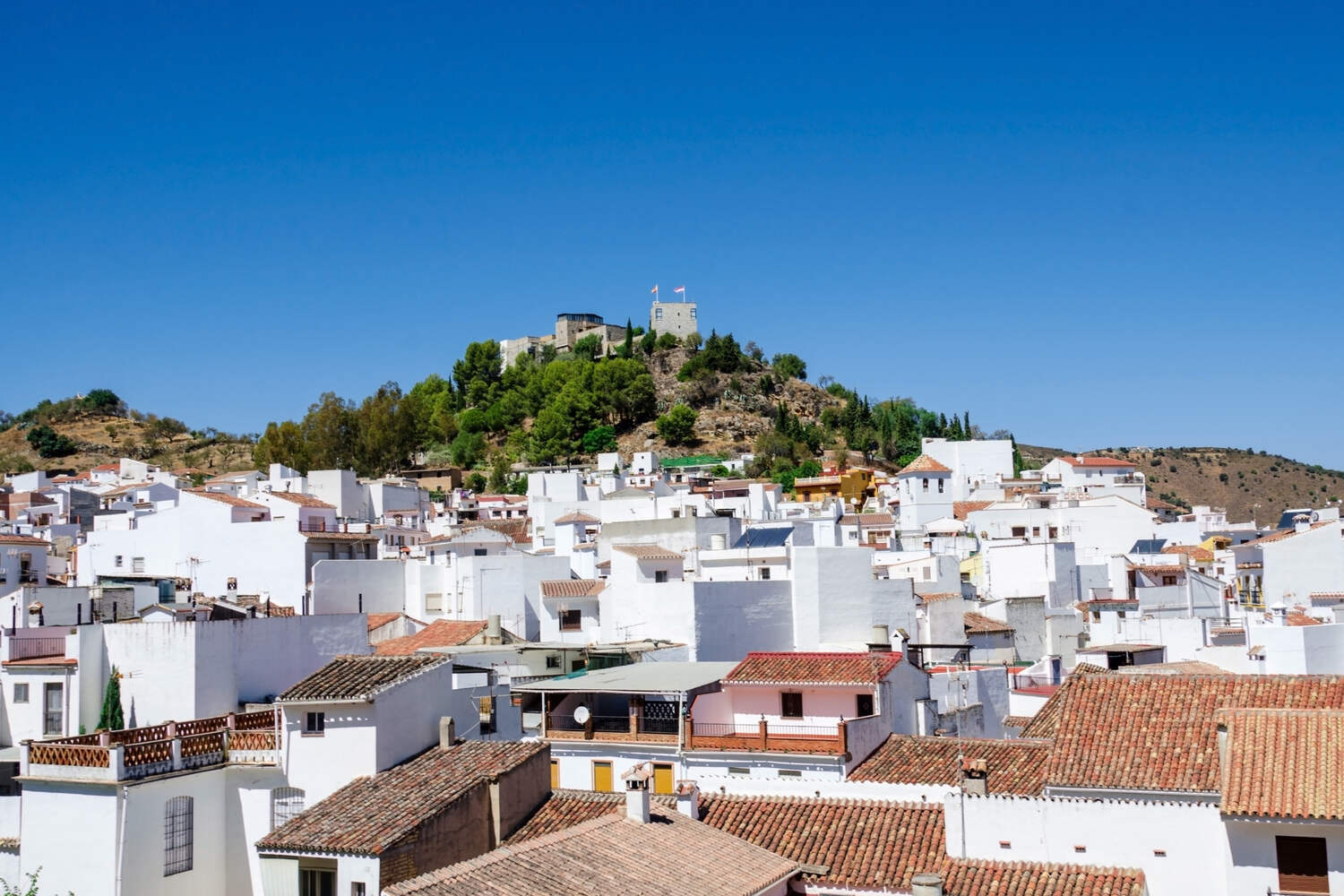
Montejaque
Montejaque is a hidden gem located about an hour and a half from Malaga, in the heart of the Sierra de Grazalema Natural Park.
This village is a hiker’s paradise, offering trails that range from gentle walks to challenging hikes, like the route through the Hundidero-Gato cave system.
As a bird watcher, you’ll have the opportunity to spot griffon vultures soaring overhead.
Montejaque also has a rich history, with the Blanquilla cave homes that date back to prehistoric times. For a unique experience, visit the Cueva de la Pileta, known for its ancient cave paintings.
This white village is perfect for adventurers and history enthusiasts, and that is definitely a nice day out from Malaga.
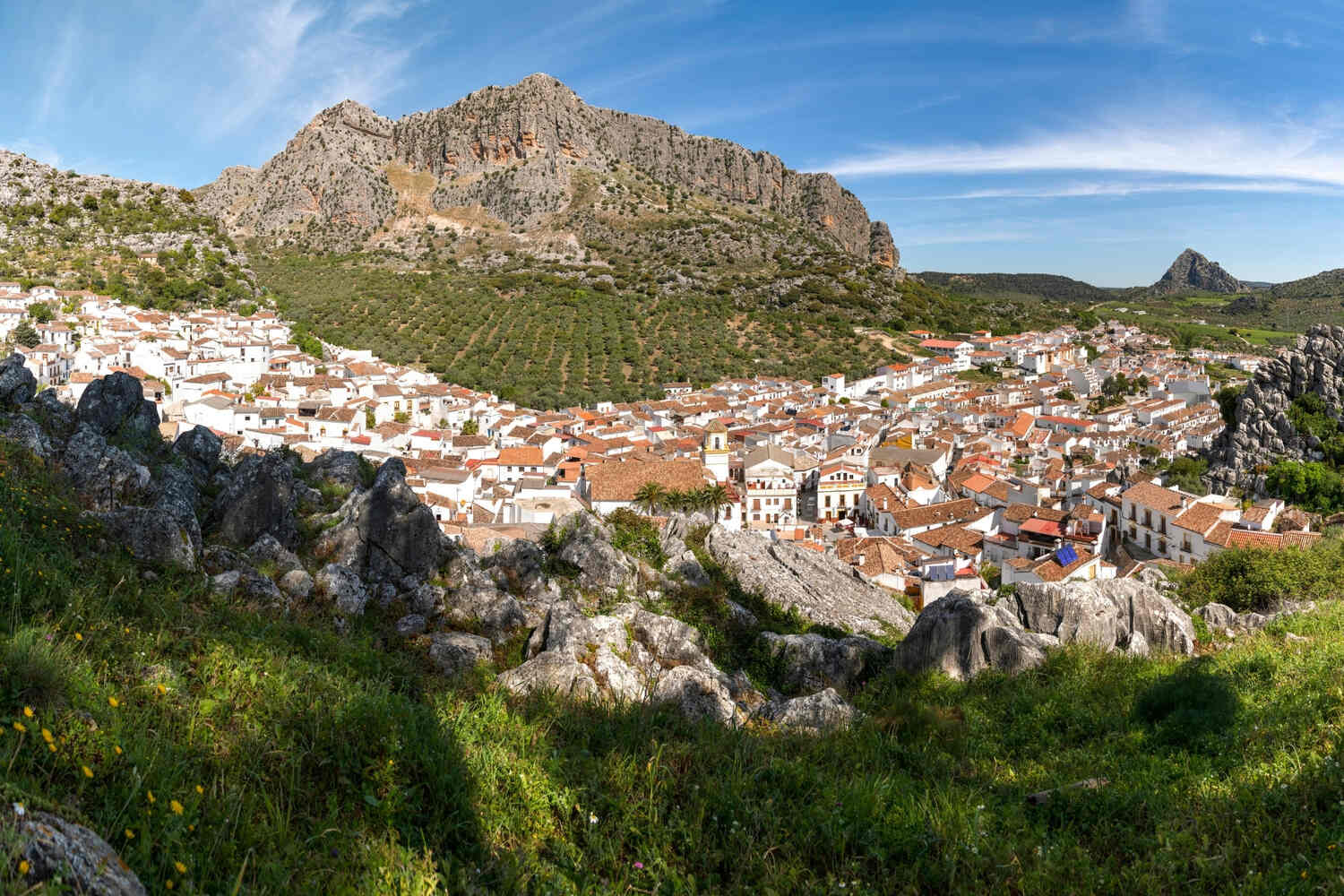
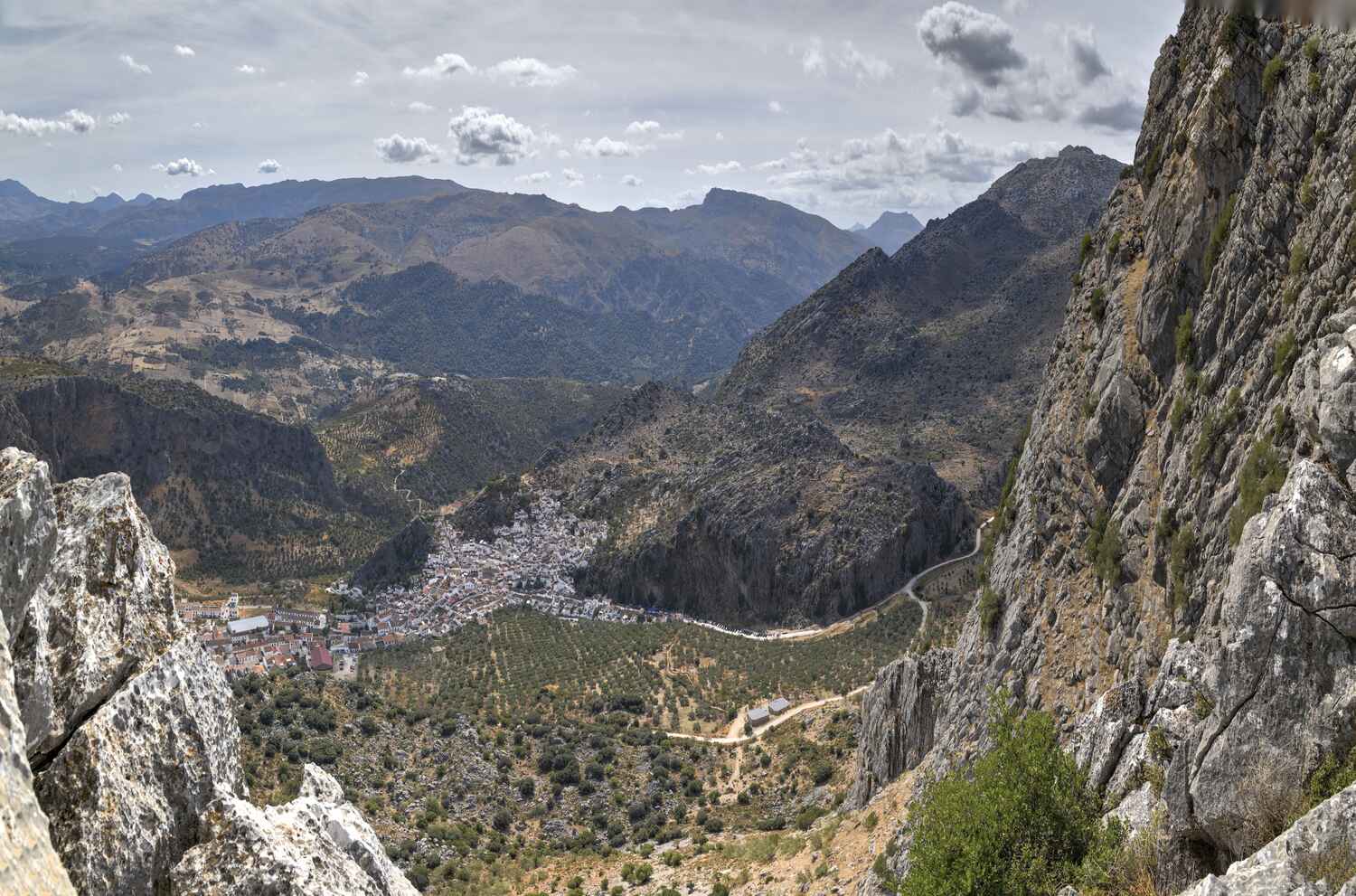
Nerja
Just 50 minutes from Malaga, Nerja offers more than just stunning beaches. Explore the famous Caves of Nerja, a spectacular natural wonder with ancient paintings and the world’s largest stalagmite.
Stroll along the Balcón de Europa, a promenade with panoramic views of the Mediterranean. Nerja’s old town is full of life, with shops, tapas bars, and the beautiful El Salvador Church.
For a refreshing dip, visit the natural pools of Maro-Cerro Gordo. Fun fact: Nerja is sometimes referred to as the “Jewel of the Costa del Sol” for its mix of natural beauty, culture, and history.
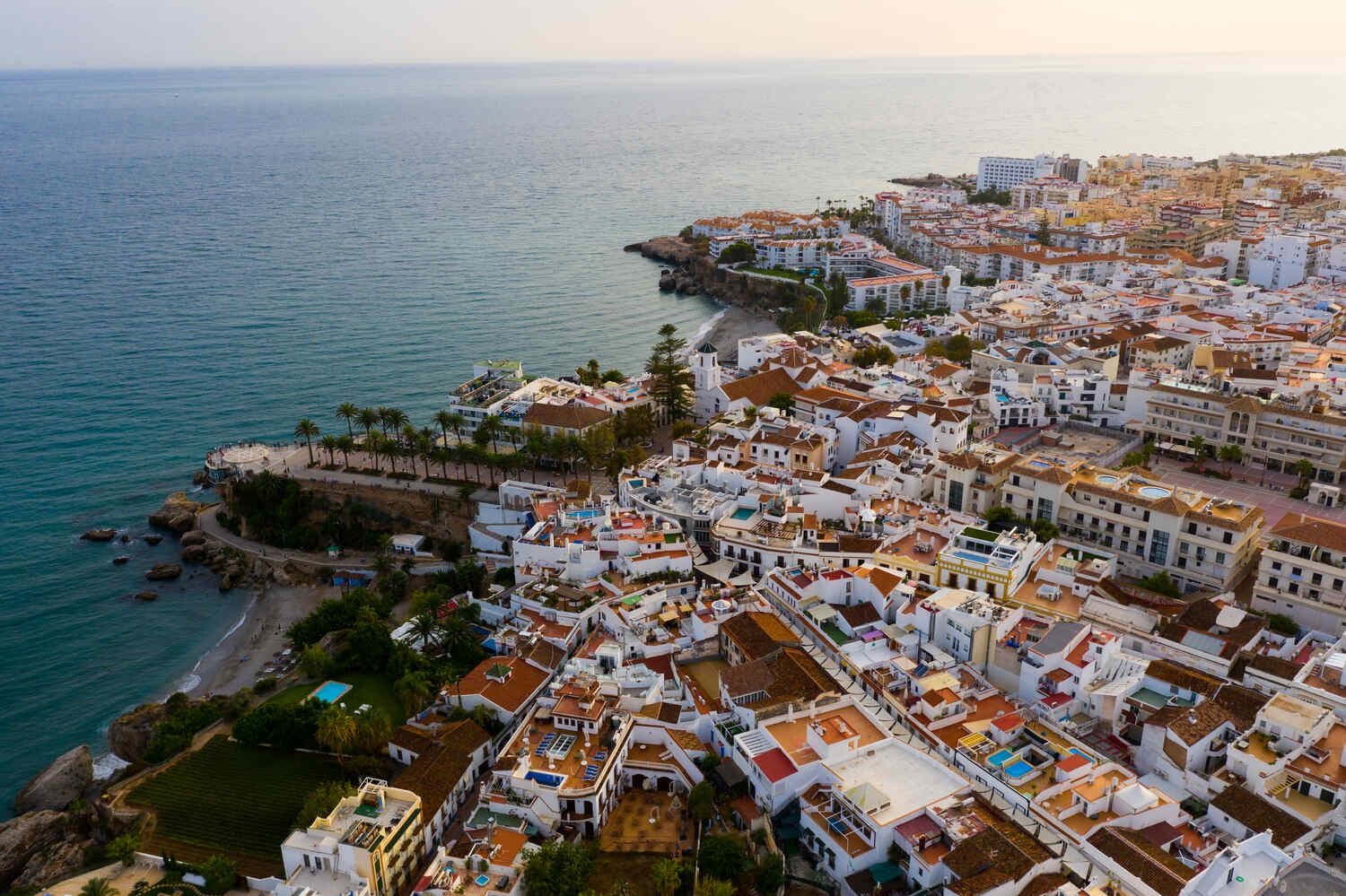
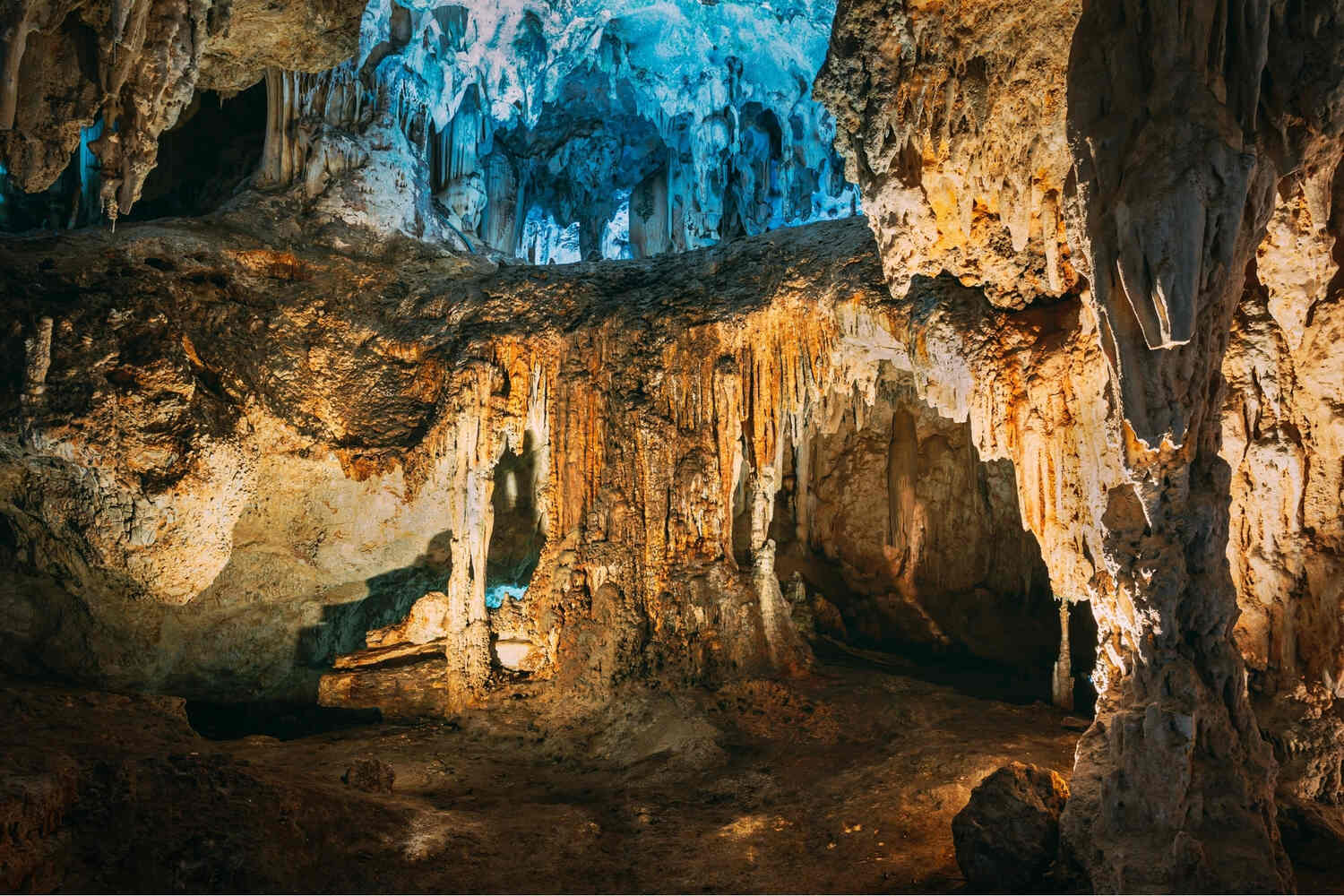
Ojén
Ojén, nestled in the mountains just 10 minutes from Marbella, is a tranquil escape from the coastal crowds.
Start your visit at the Eco-museum to learn about the village’s traditional industries, including olive oil and charcoal production. The Juanar area is great for hiking, with trails leading to stunning viewpoints like Mirador del Corzo.
Ojén’s charming old town, with its narrow streets and white houses, is perfect for a leisurely stroll. A unique local product to try is the “aguardiente de Ojén,” a traditional spirit.
Ojén combines natural beauty with a rich cultural heritage, making it one of the best white villages in Andalucia, which I’m confident you will love.
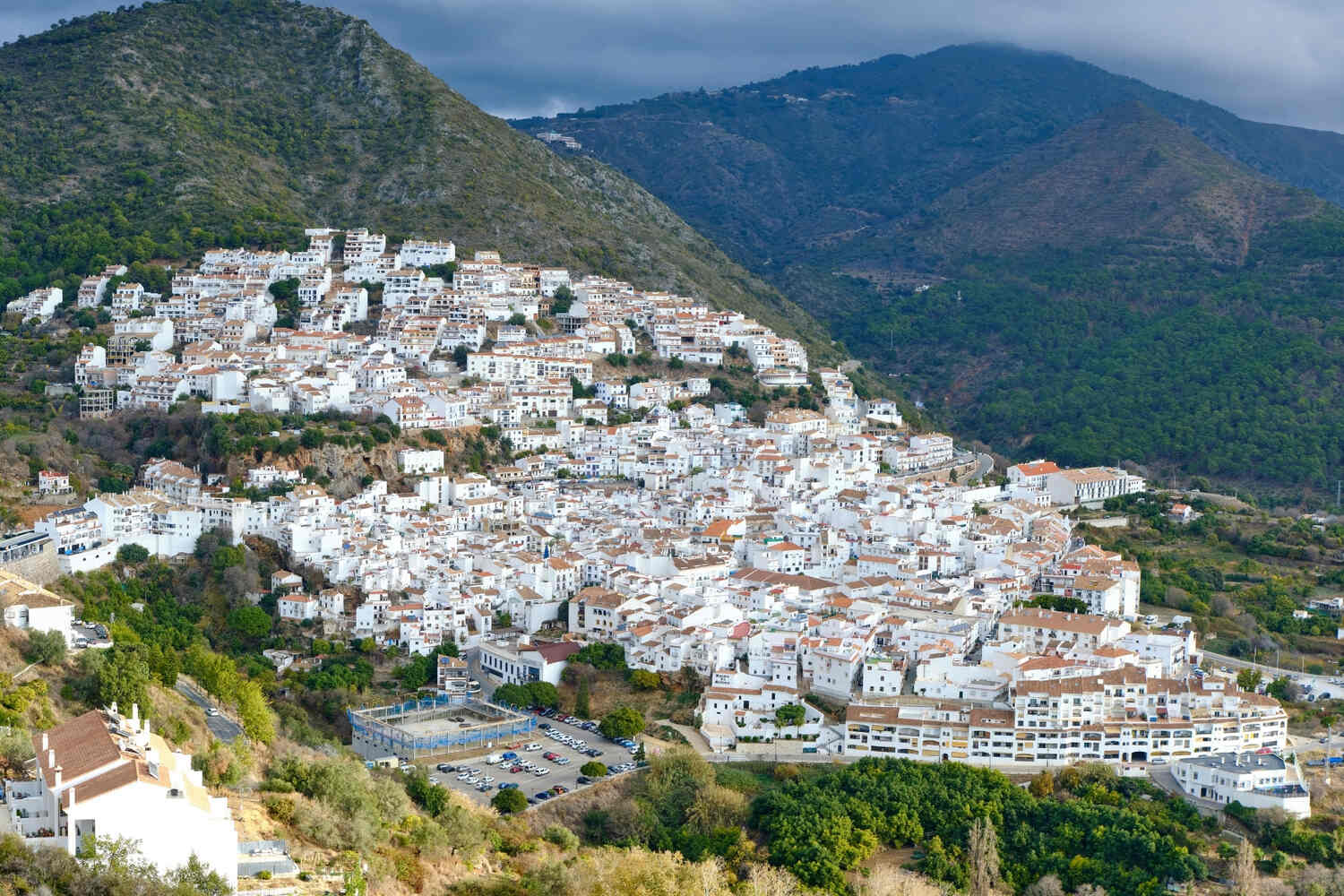
Ronda
Ronda, about an hour from Malaga, is dramatically set atop a deep gorge, and it’s easily one of my favorite white villages of Andalucia, one that I’m certain I’ll come back to, and for endless reasons.
The Puente Nuevo bridge offers iconic views and a peek into the town’s Moorish past. Wander the historic streets, visit the bullring—one of the oldest and most picturesque in Spain—and explore the Palacio de Mondragon.
All in all, when you spend a day in Ronda, you’re guaranteed some fun and some “wow!”.
Ronda is also known for its wineries, offering tastings of local Andalusian wines. A fascinating fact: Ronda is considered the birthplace of modern bullfighting, celebrated in its museum and annual festivals.
While it’s near Malaga, the best day tours leave from Seville, so you’ll want to keep that in mind if you plan to spend a few days in Seville.
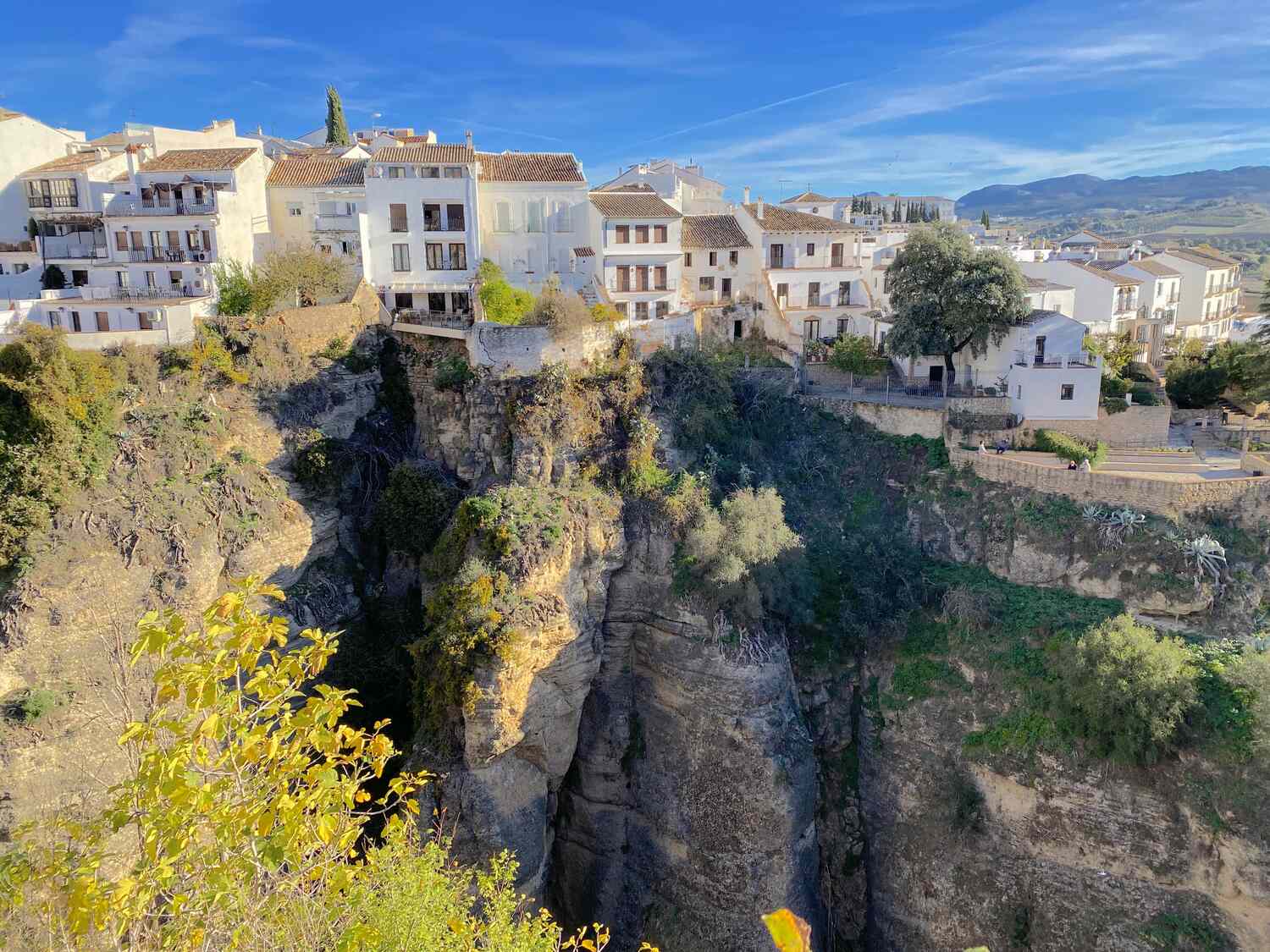
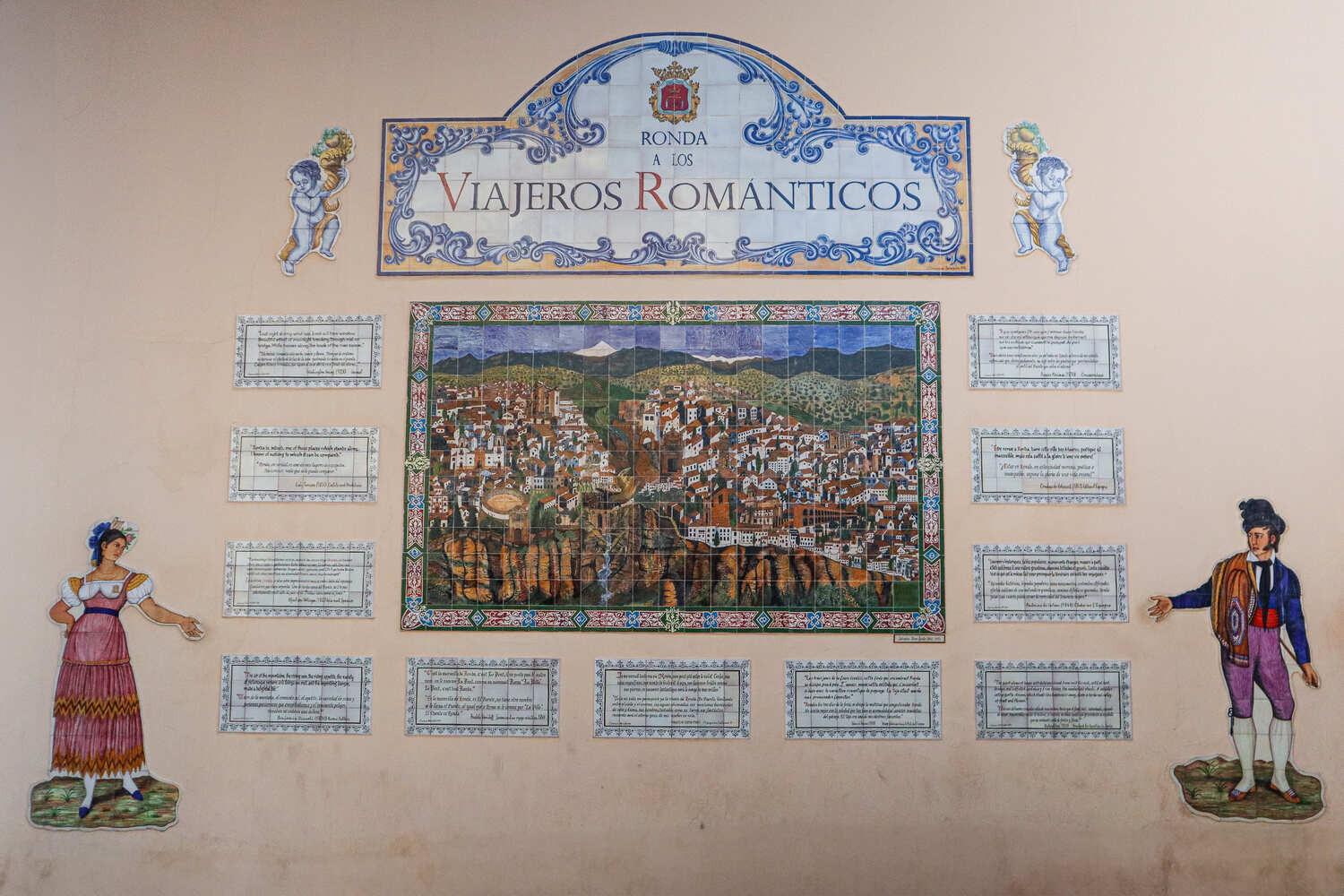
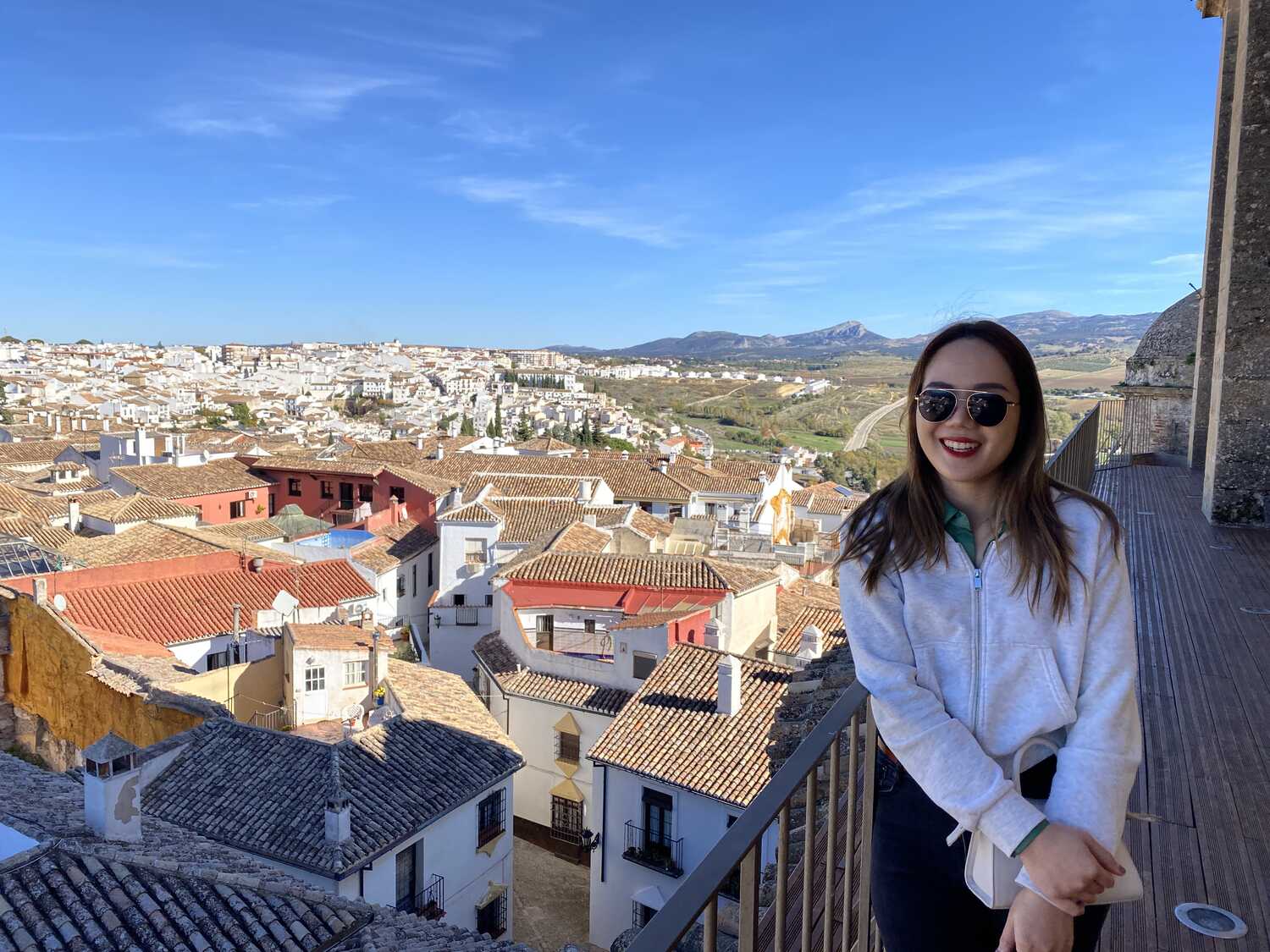
Torrox Pueblo
Torrox Pueblo, located about 40 minutes from Malaga, boasts the best climate in Europe.
This charming village is a labyrinth of narrow streets adorned with flowers and whitewashed houses. Visit the main town square, Plaza de la Constitución, for a taste of local life and the 16th-century Church of Our Lady of the Incarnation.
The ancient Roman city (now ruins) nearby offer a glimpse into the area’s ancient past. For a relaxing day, the Torrox Costa, with its promenade and beaches, is just a short drive away.
Torrox Pueblo Blanco is a blend of history, culture, and relaxation, ideal if you want a peaceful getaway.
Also, if you come from Malaga, you can stop on the road back from the Nerja Caves, which is a nice way to combine both Pueblos Blancos in Andalucia in one day.
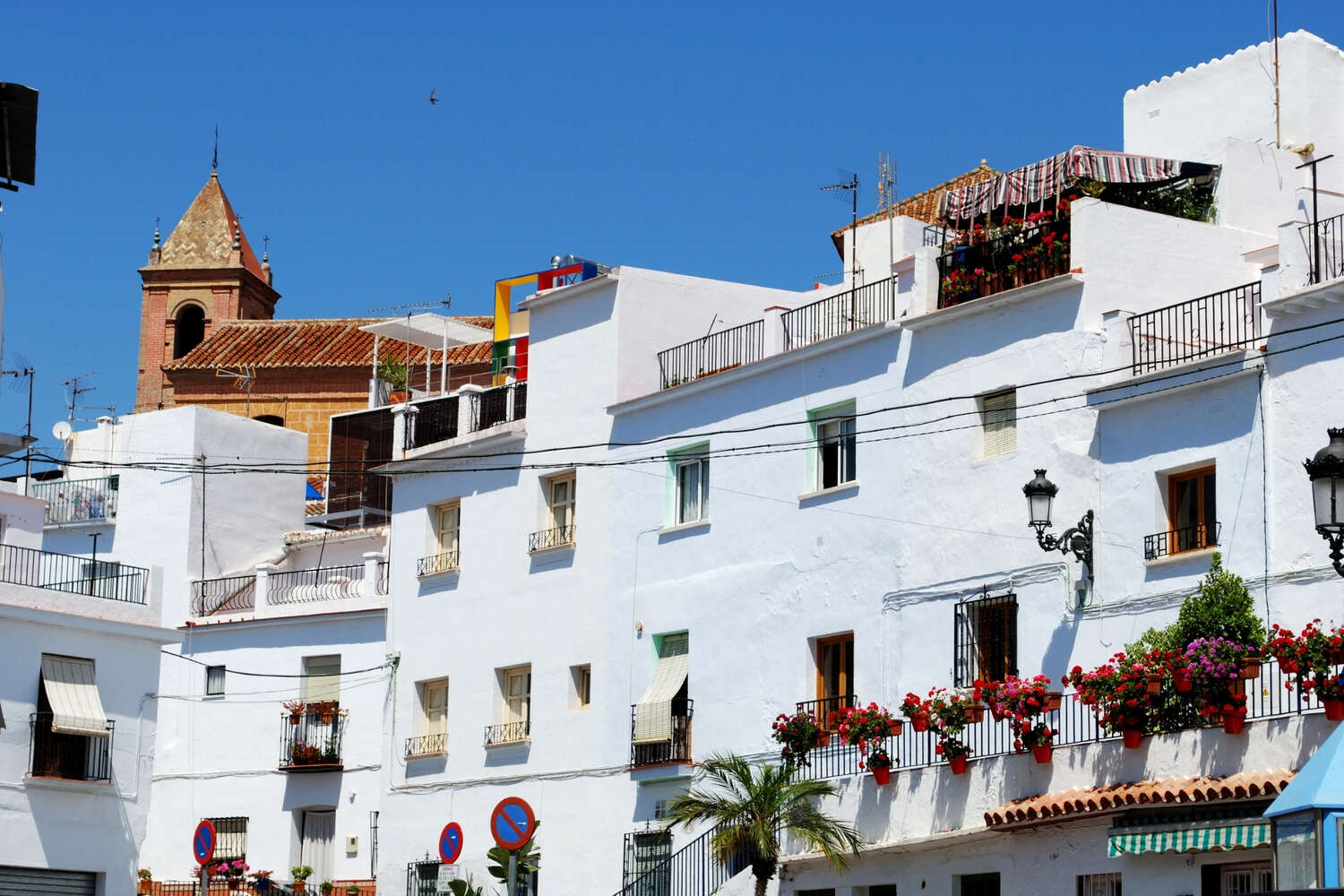
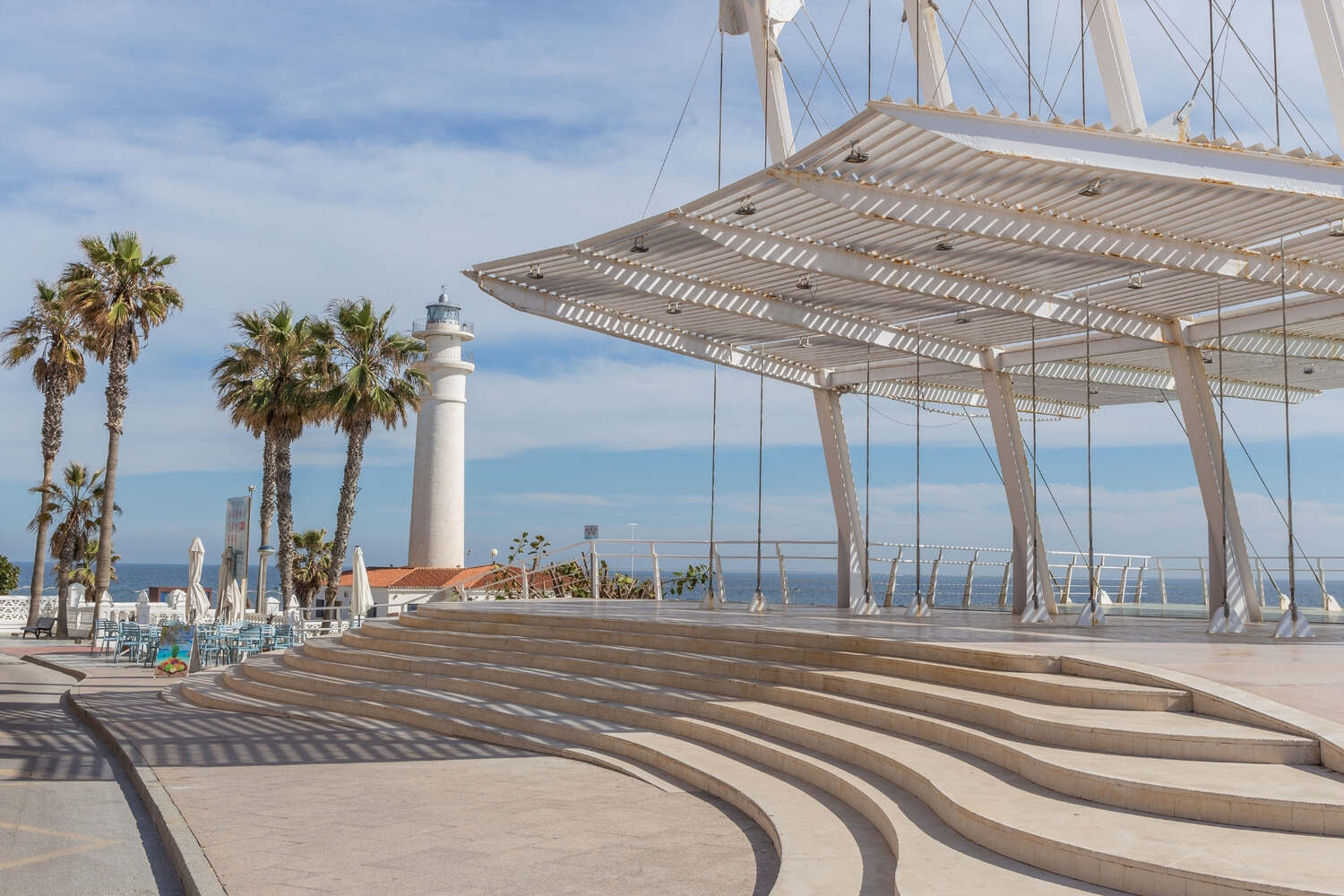
White Villages Near Cadiz
Step into a postcard scene with the White Villages near Cadiz, where history whispers from every corner. Each village, a stone’s throw from the vibrant city of Cadiz, boasts unique tales, stunning vistas, and a chance to unwind.
It’s an easy escape to Spain’s heart, where traditions thrive amidst serene beauty, and this is your chance to meet the more remote, unknown parts of south Spain in the surrounding mountains.
From the famous mountain village of Setenil de las Bodegas to more remote ones like Zahara de la Sierra, you’re in for a treat.
Arcos de la Frontera
Just an hour from Cadiz, Arcos de la Frontera is a cliffside wonder, inviting visitors to meander through its historical streets. Start at the Basilica of Santa María, then head to the Castle of Arcos for a dive into the past.
Don’t miss the Parador de Arcos for a coffee with a view. For a taste of local life, stroll down to the river for a picnic or kayak adventure.
If you like golf, you will enjoy Arcos Gardens, a stunning course nearby. Arcos combines natural beauty, history, and leisure in one picturesque package.
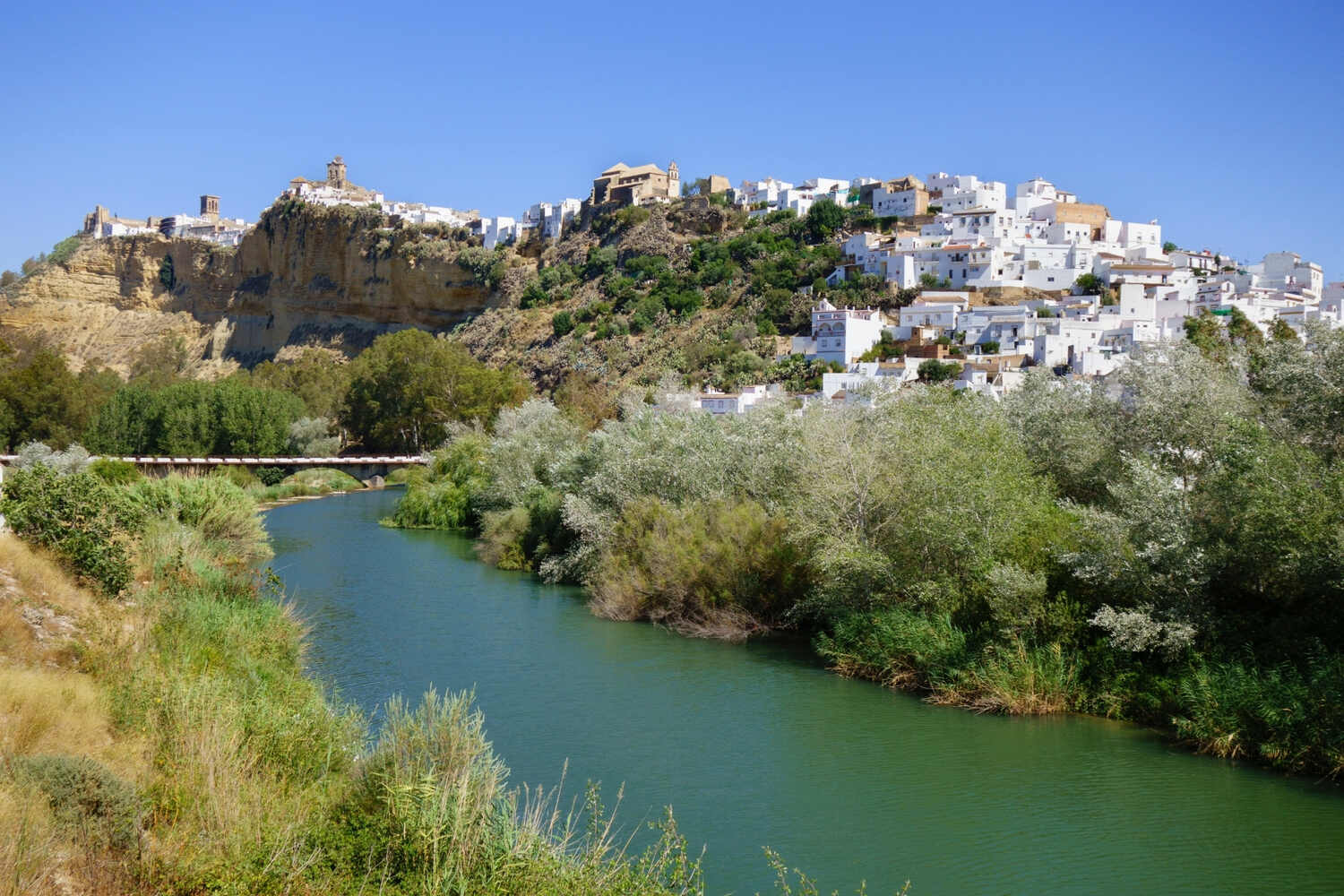
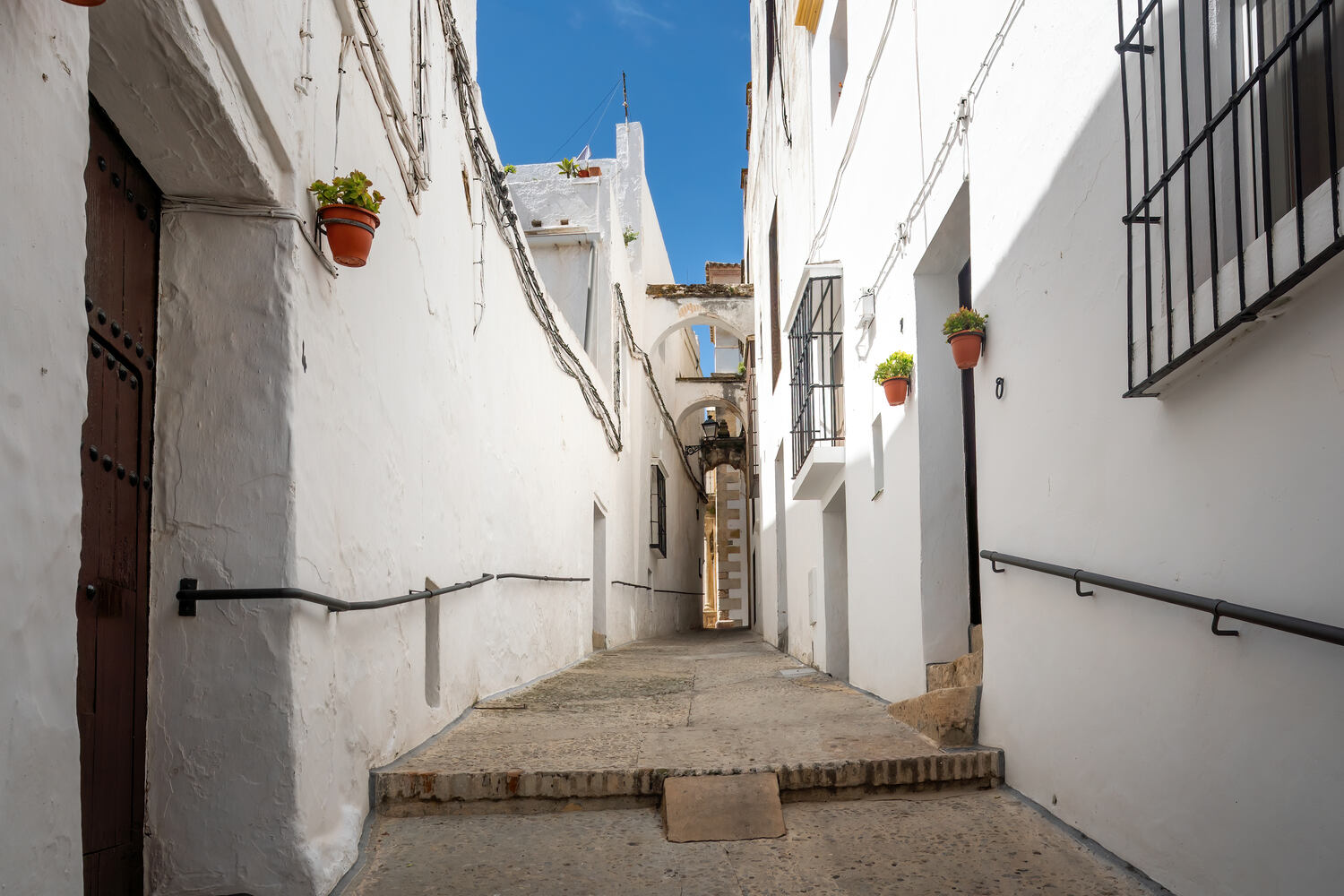
Grazalema
Grazalema, nestled in its namesake natural park about 1.5 hours from Seville, is perfect for nature lovers. Hike the Pinsapar trail for a glimpse of rare Spanish fir trees, or explore the Garganta Verde gorge for breathtaking views.
The village itself offers cozy cafes and shops selling local wool products. For a cultural touch, visit the Church of San José. Nearby, the Embalse de Zahara-El Gastor is ideal for a relaxing afternoon or some bird watching.
Grazalema is a haven for those seeking tranquility and outdoor adventure.
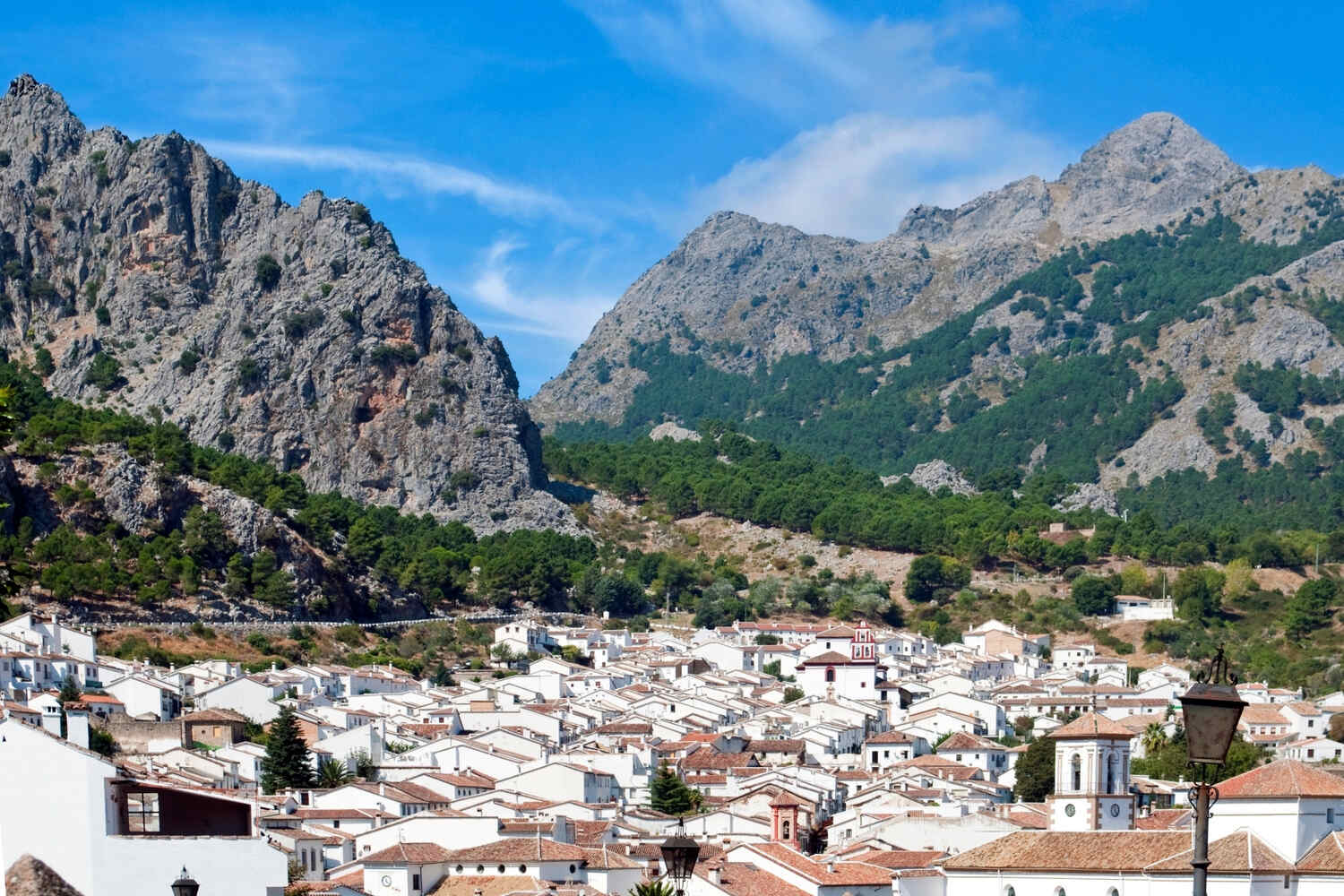
Medina Sidonia
Medina Sidonia, an hour from Cadiz, is steeped in history from Roman times to the present. Explore ancient ruins and the Arco de la Pastora. The Castle offers panoramic views you can’t miss.
For a taste of local sweetness, visit a traditional pastry shop for “alfajores.” Take a guided tour to learn about the town’s honey production, another local specialty.
In June, the Patio Festival showcases the town’s beautiful courtyards. Medina Sidonia offers a deep dive into Andalusia’s rich cultural tapestry.
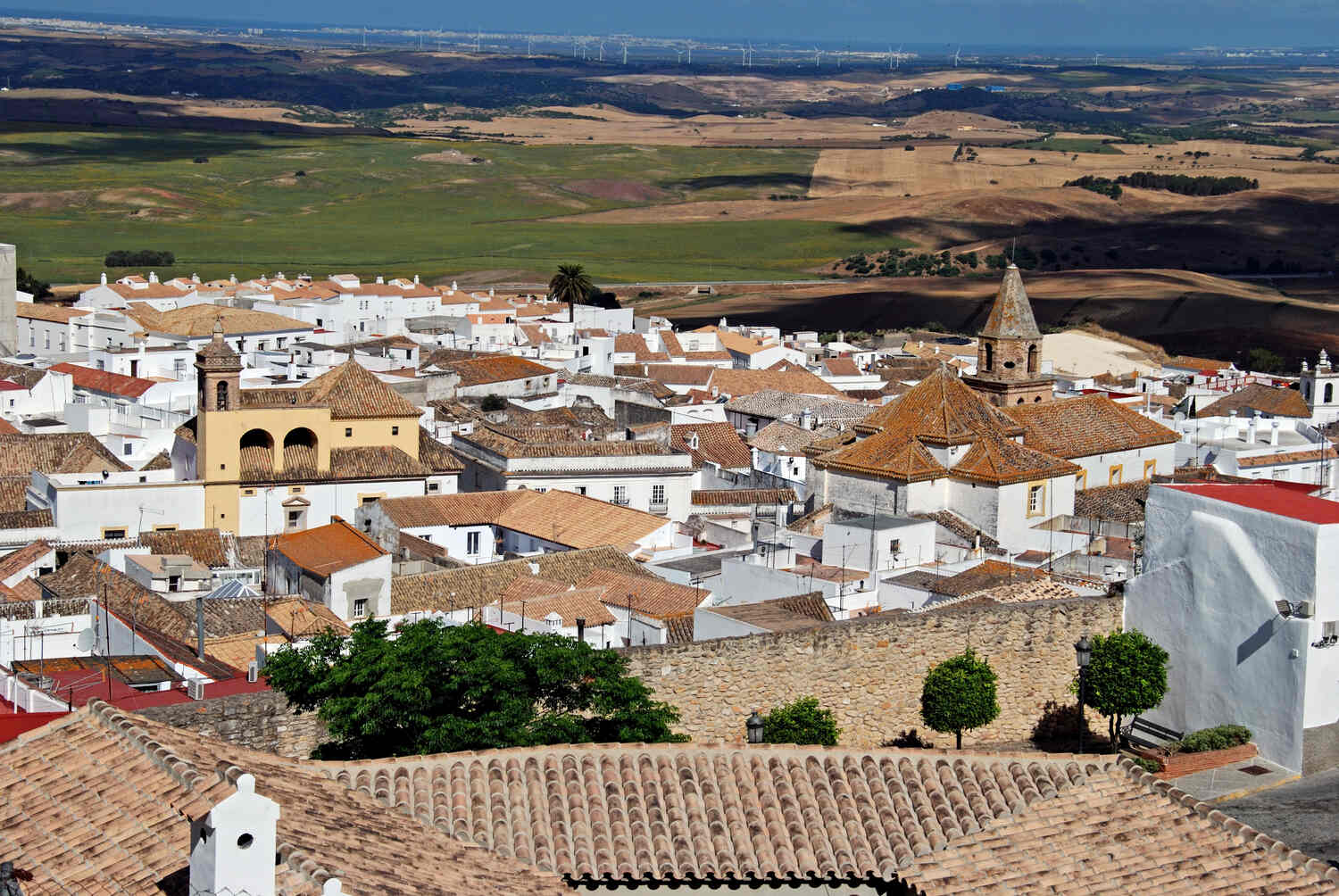
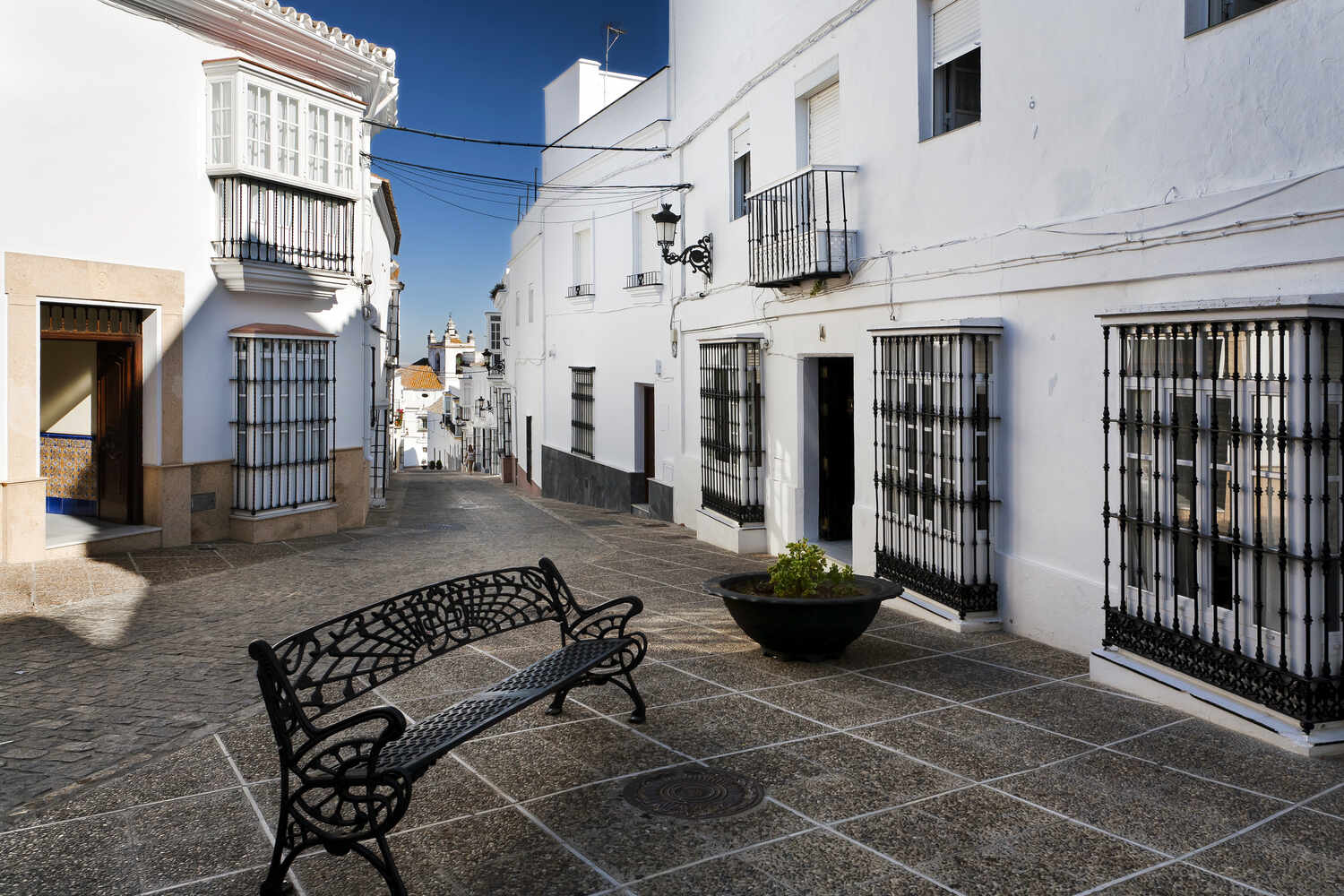
Olvera
Olvera, about 1.5 hours from Seville, stands out with its iconic church and castle. Delve into local history at the Olive Oil Museum and sample some of the region’s best oils.
The Via Verde offers leisurely bike rides or walks with stunning views. For a spiritual journey, follow the Pilgrimage Route leading to the Sanctuary of the Remedies.
The town’s annual Easter procession is a deeply moving cultural experience. Olvera is a blend of natural beauty, tradition, and culinary delights, making it a must-visit for those exploring rural Andalusia.
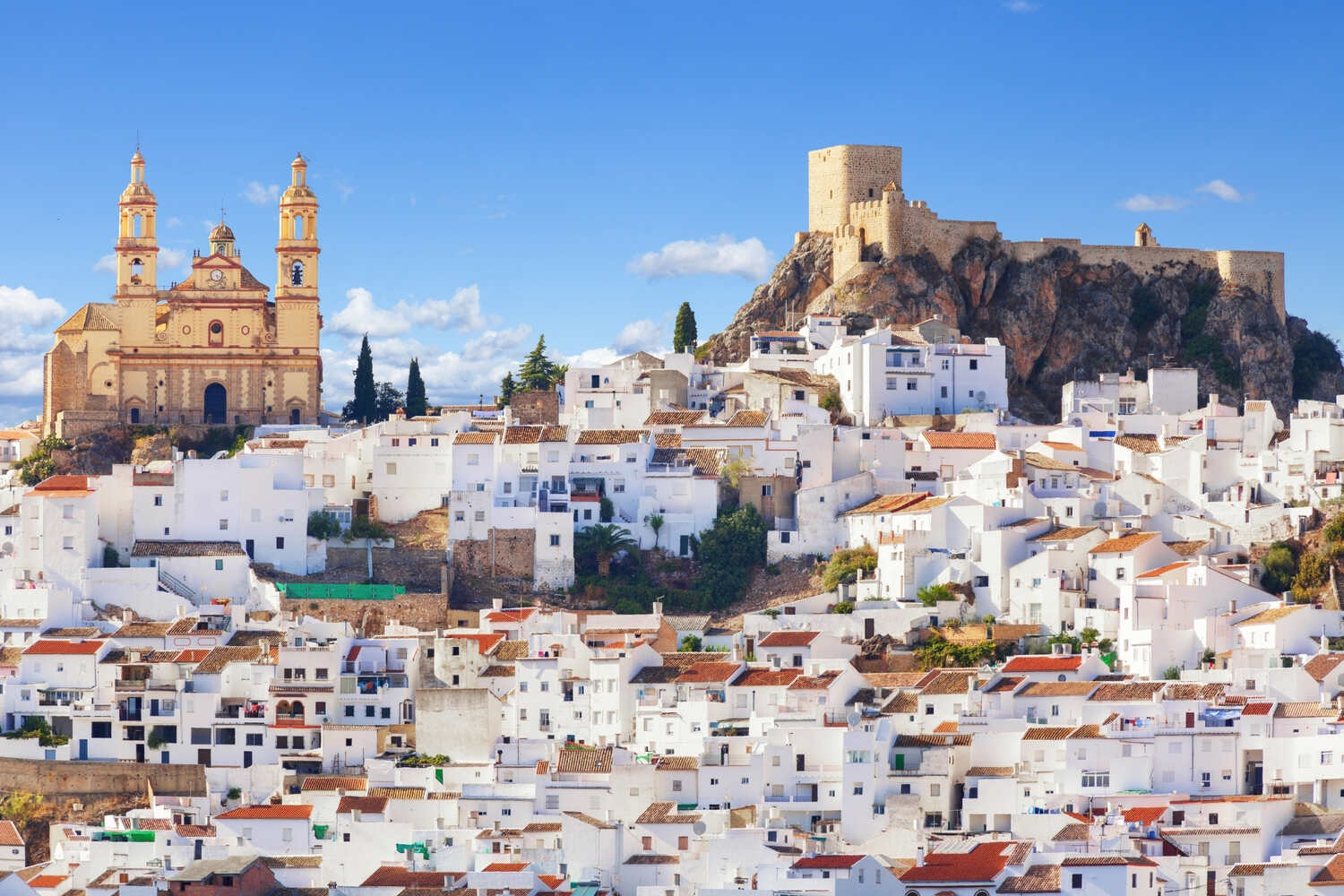
Setenil de las Bodegas
Setenil de las Bodegas, just over an hour from Seville, captivates visitors with its rock-hewn dwellings. Explore the town’s unique architecture by walking along Calle Cuevas del Sol.
The Castle of Setenil offers a historical escape, while local bars tucked under the rocks serve up delicious tapas. Venture into the surrounding countryside for a day of hiking or cycling.
The local market is a great place to sample regional products, including the town’s famous pastries. Setenil is a fascinating mix of natural wonders and culinary experiences.
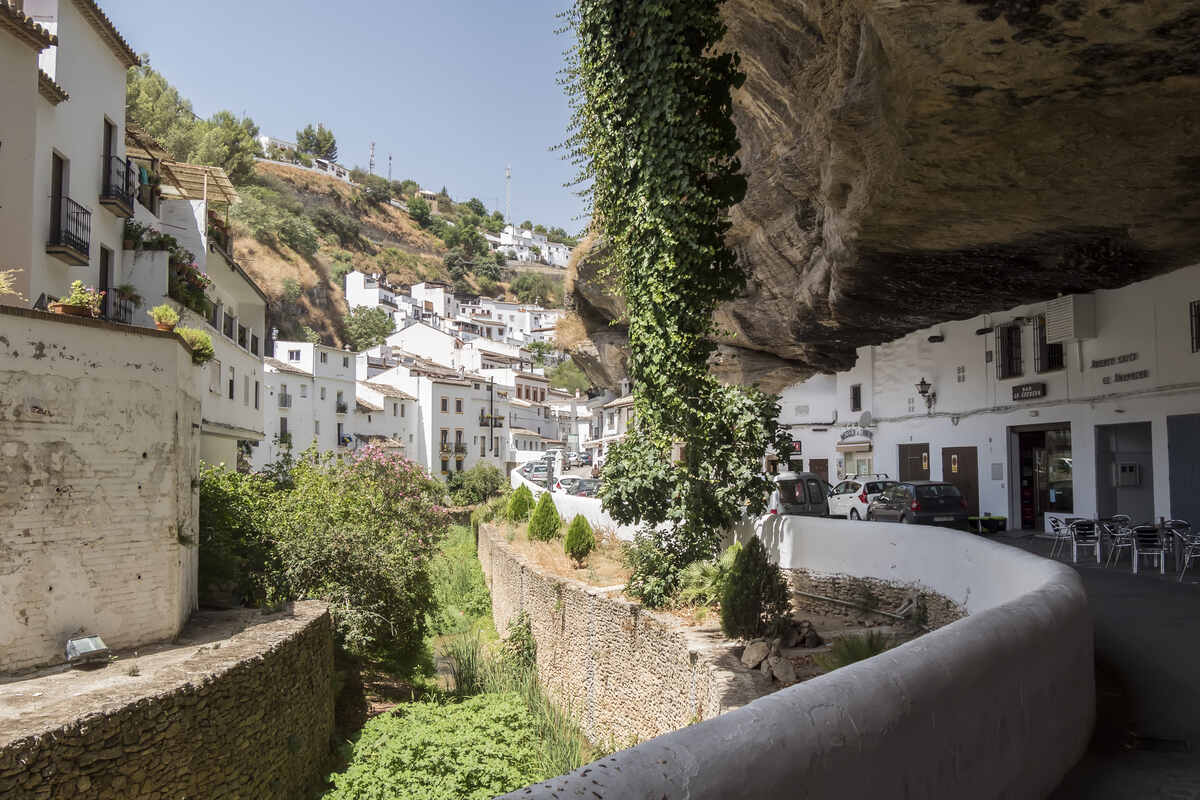
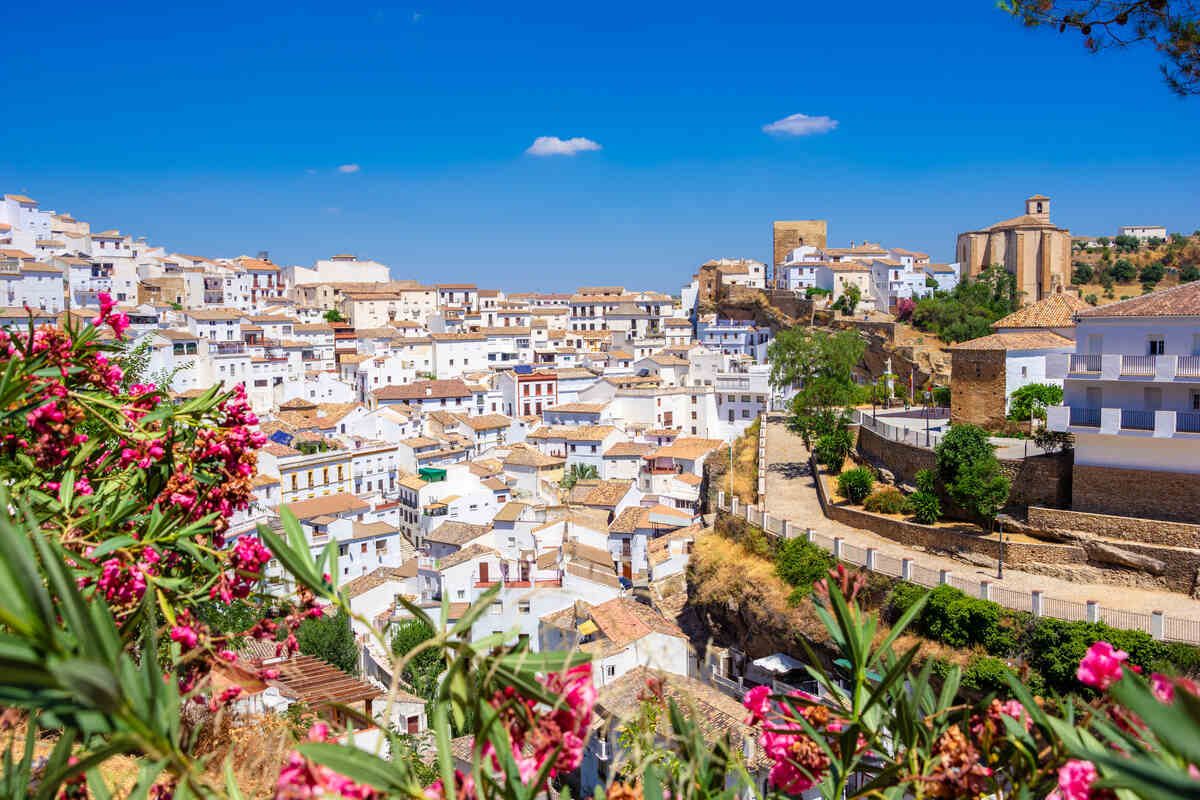
Ubrique
Ubrique, nestled in the Sierra de Cádiz about 1.5 hours from Cadiz, is famous for its leather goods. Visit the Leather Museum to delve into this craft’s history, then explore artisan shops for unique souvenirs.
The town’s Roman ruins offer a historical outing, while the nearby Sierra de Grazalema Natural Park is perfect for hiking.
For a quirky experience, check out the town’s annual bull run. Ubrique’s combination of cultural heritage, natural beauty, and unique traditions offers something for everyone.
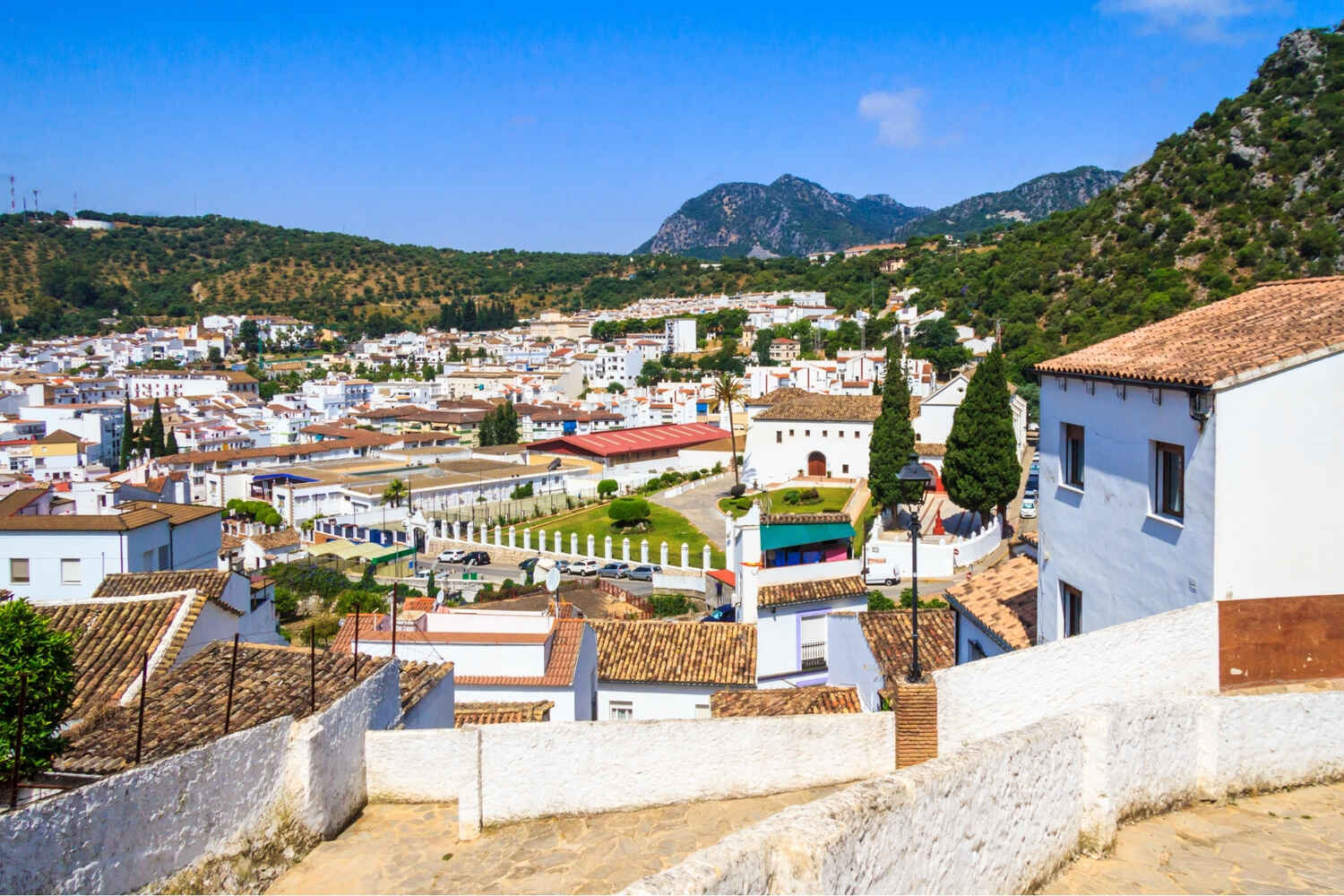
Vejer de la Frontera
Vejer de la Frontera, perched atop a hill 50 minutes from Cadiz, mesmerizes with its whitewashed buildings and stunning vistas. Wander the old town’s labyrinthine streets to the Plaza de España and the Castle.
For art enthusiasts, the NMAC Foundation showcases contemporary art in a natural setting. The windmills of Santa Lucía offer a picturesque hike.
Culinary tours here introduce visitors to Andalusian cuisine, with a focus on local tuna. Vejer’s blend of history, culture, and gastronomy makes it a standout destination.
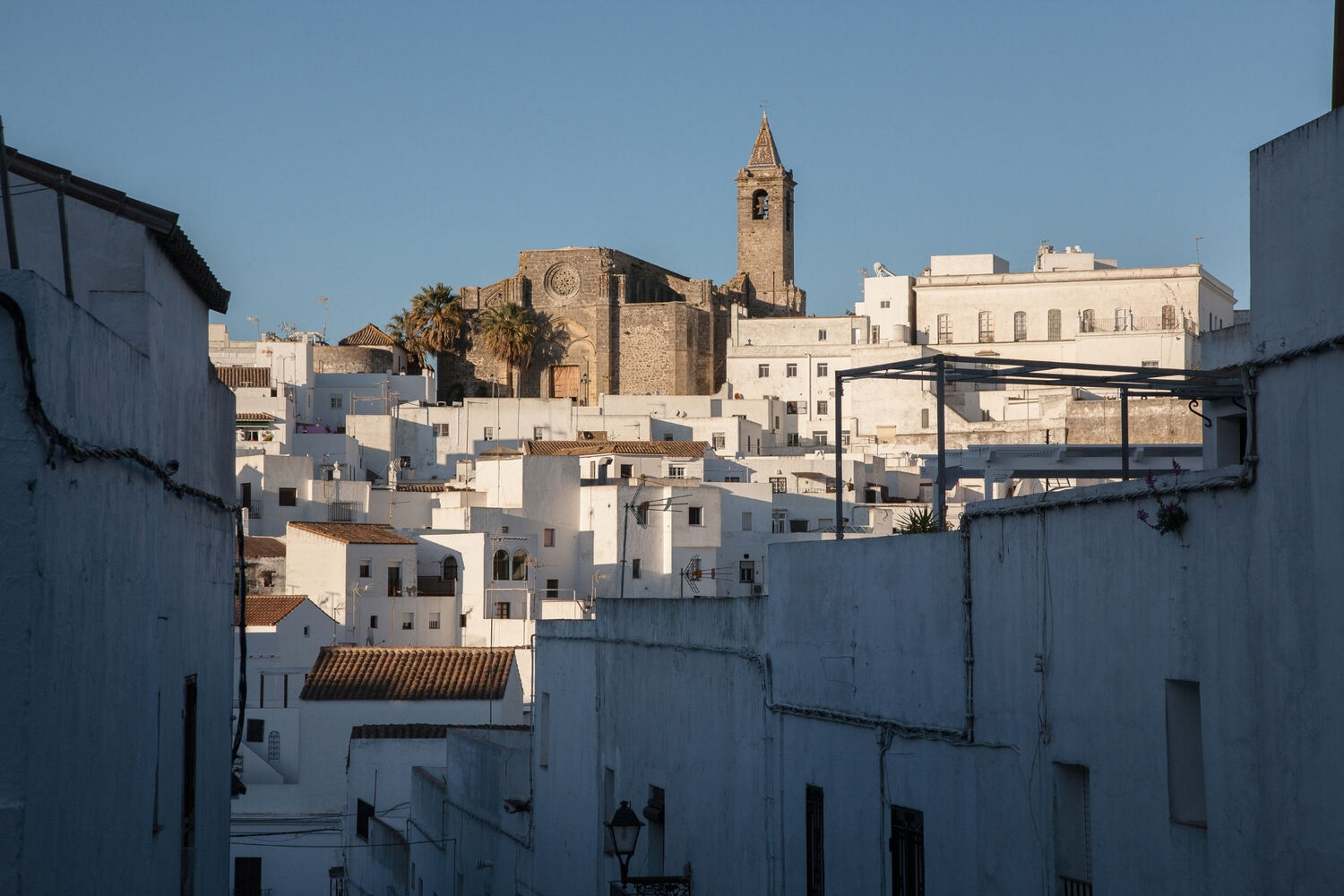
Zahara de la Sierra
Zahara de la Sierra, located about 1.5 hours from Seville, is a jewel in the Andalusian countryside. The castle ruins provide not just history but also panoramic views of the azure reservoir below.
Embark on a water adventure with a canoe or paddleboard on the lake. The Santa María de la Mesa Church is a must-visit for its architectural beauty. Join a guided tour of the local olive oil mill to understand the production process and enjoy tastings.
Zahara is a captivating mix of adventure, history, and culinary discovery, embodying the spirit of the Pueblos Blancos.
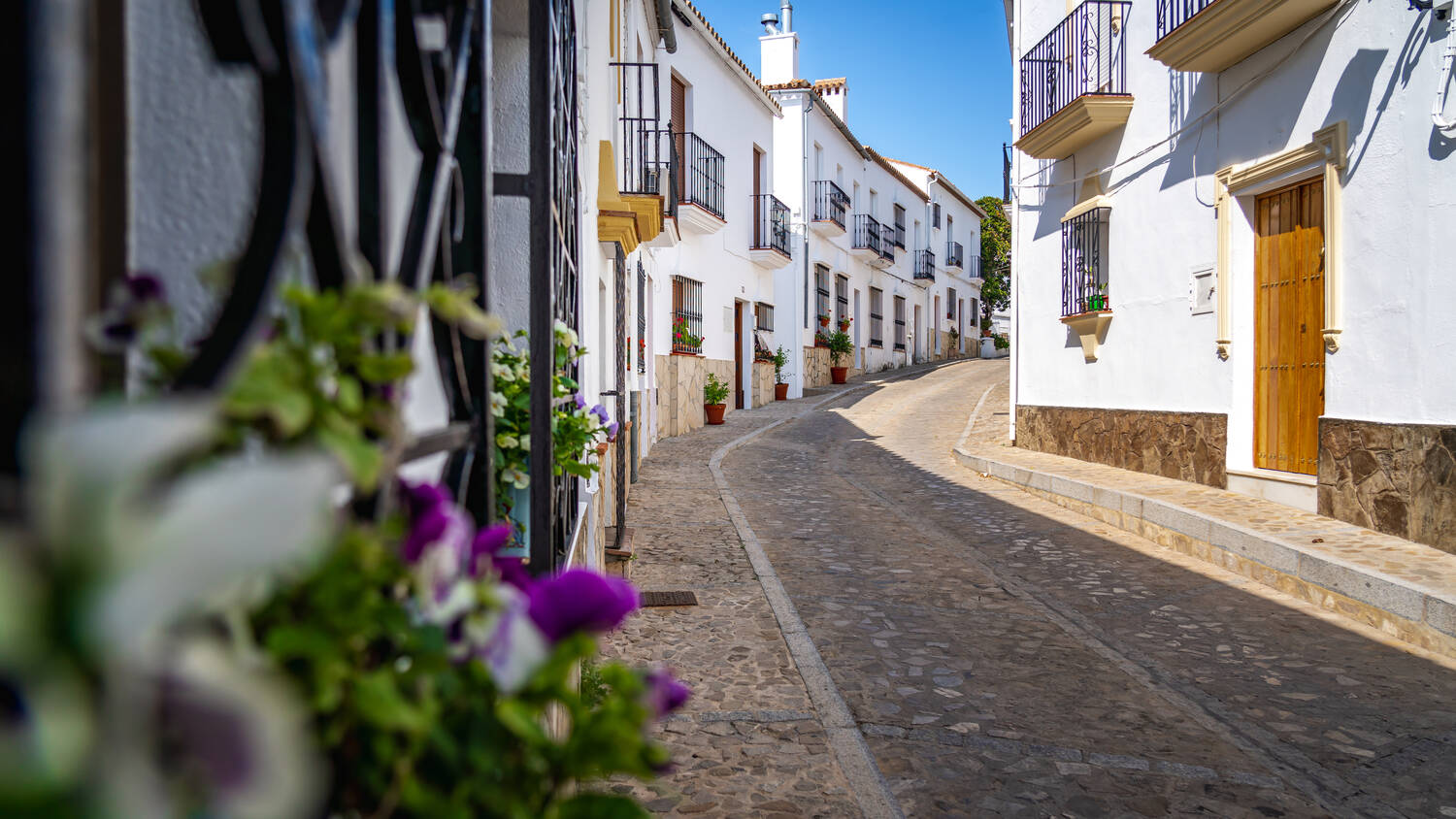
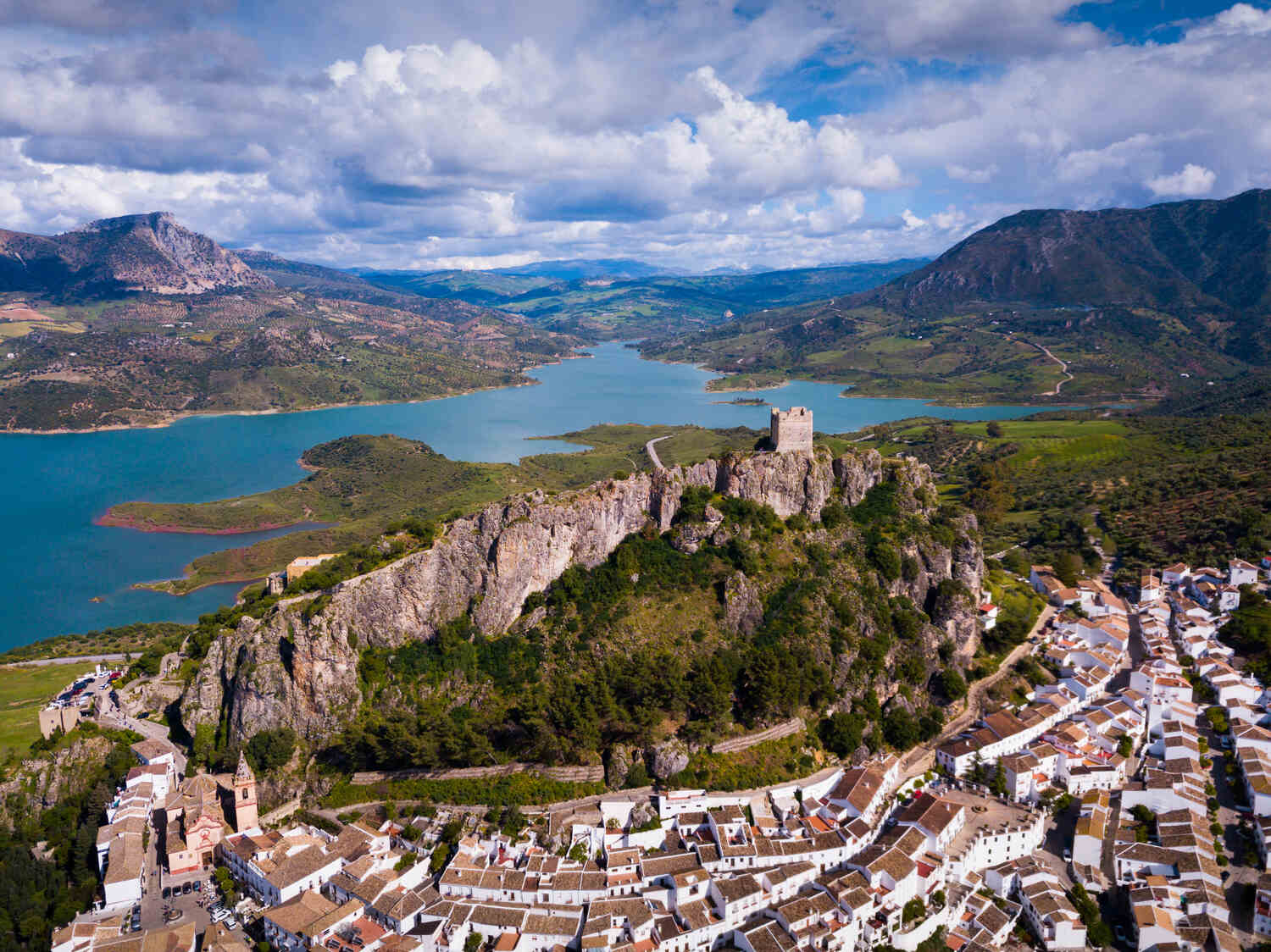
White Villages Near Cordoba, Granada, and Jaen
Dive into the heart of Andalusia with picturesque villages near Cordoba, Granada, and Jaen. Here, among olive groves and ancient forts, the soul of Spain comes alive.
Just a hop from the historical cities, these gorgeous villages offer a peaceful retreat into a land where time slows down, ideal for those seeking tranquility and a deep cultural immersion.
Zuheros
Zuheros, nestled in the Sierras Subbéticas Natural Park and about 1.5 hours from Cordoba, is a scenic village that seems to have sprung from a fairy tale. Wander through its cobblestone streets to the Zuheros Castle for stunning views.
The Cueva de los Murciélagos offers fascinating prehistoric cave paintings and formations. Cheese lovers can’t miss the Cheese Museum, showcasing local artisan cheeses with tastings.
Hiking trails abound in the natural park, offering paths for all skill levels. Zuheros is a perfect blend of natural beauty, history, and gastronomy, making it a hidden gem in Andalusia.
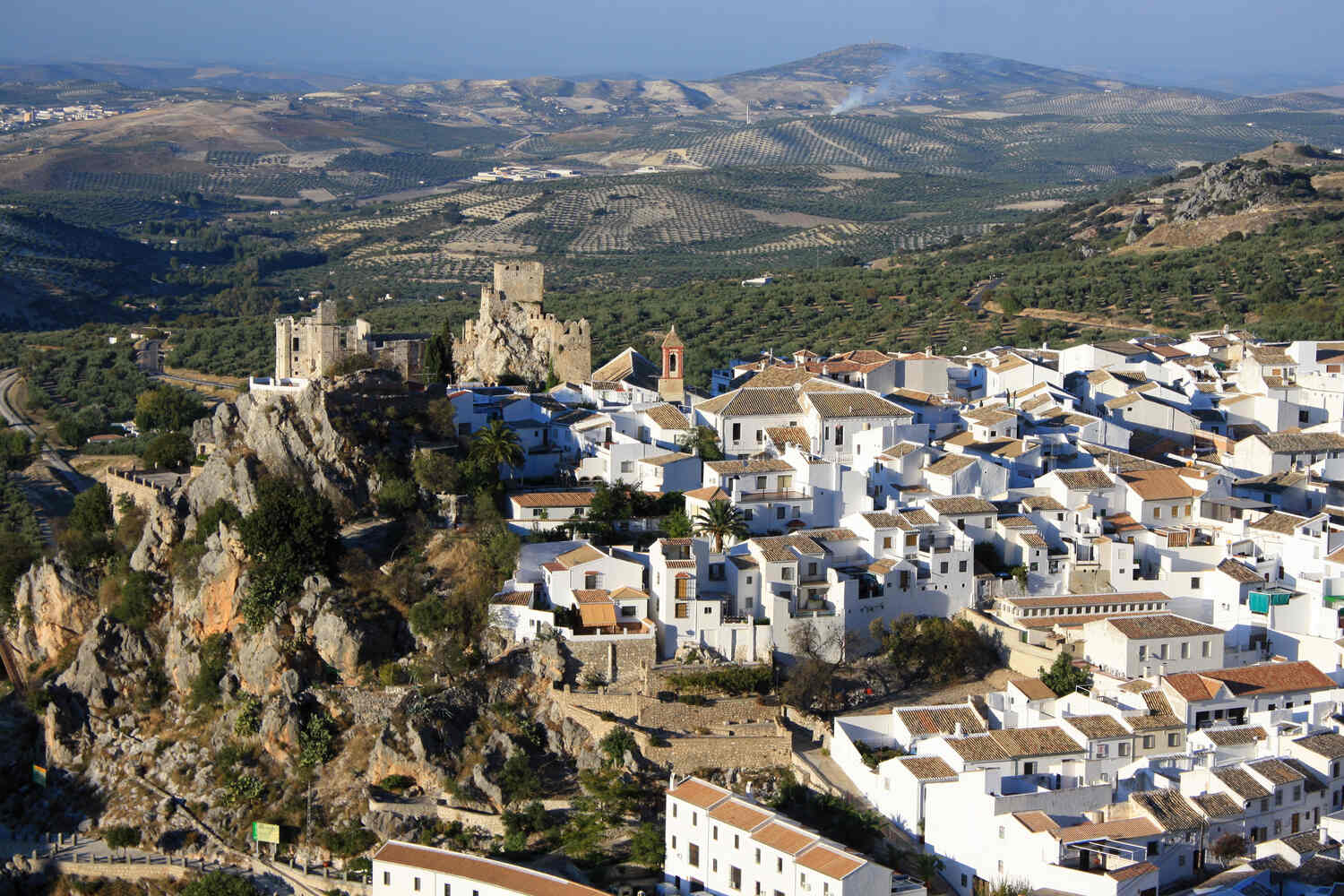
Baños de la Encina, Jaen
Baños de la Encina is about an hour from Jaen, known for its remarkably preserved Moorish castle, Burgalimar, which offers breathtaking views and a deep dive into medieval history.
The village’s ancient olive groves are perfect for a leisurely walk, leading you to some of the oldest olive trees in Spain. Explore the local church and town hall, Iglesia de San Mateo, for its impressive architecture.
Baños de la Encina also offers delightful culinary experiences, especially olive oil tastings. This village is a testament to the rich cultural tapestry and natural beauty of Andalusia.
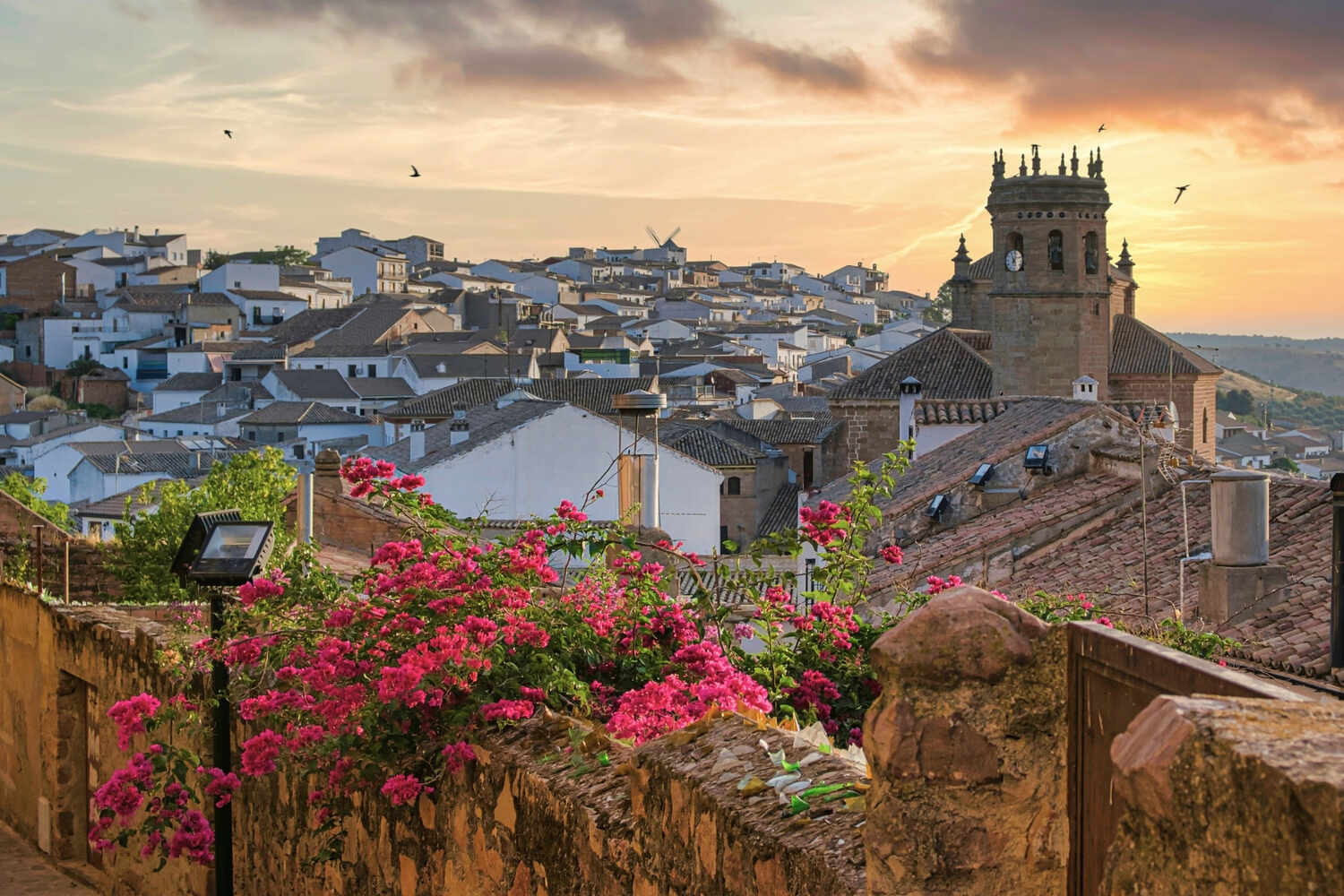
Cazorla, Jaen
Cazorla, located at the entrance to the Sierras de Cazorla, Segura y Las Villas Natural Park and about 2 hours from Jaen, is a haven for outdoor enthusiasts. The Castillo de la Yedra, perched above the town, provides historical insights and panoramic views.
The town serves as a gateway to countless hiking trails, including the route to the Salto de la Cordera waterfall.
Plaza de Santa Maria is the heart of Cazorla, where you can admire the ruins of Santa María Church. The local cuisine, rich in game and trout, offers a taste of the region’s culinary traditions.
Cazorla’s blend of nature, history, and gastronomy makes it an essential stop.
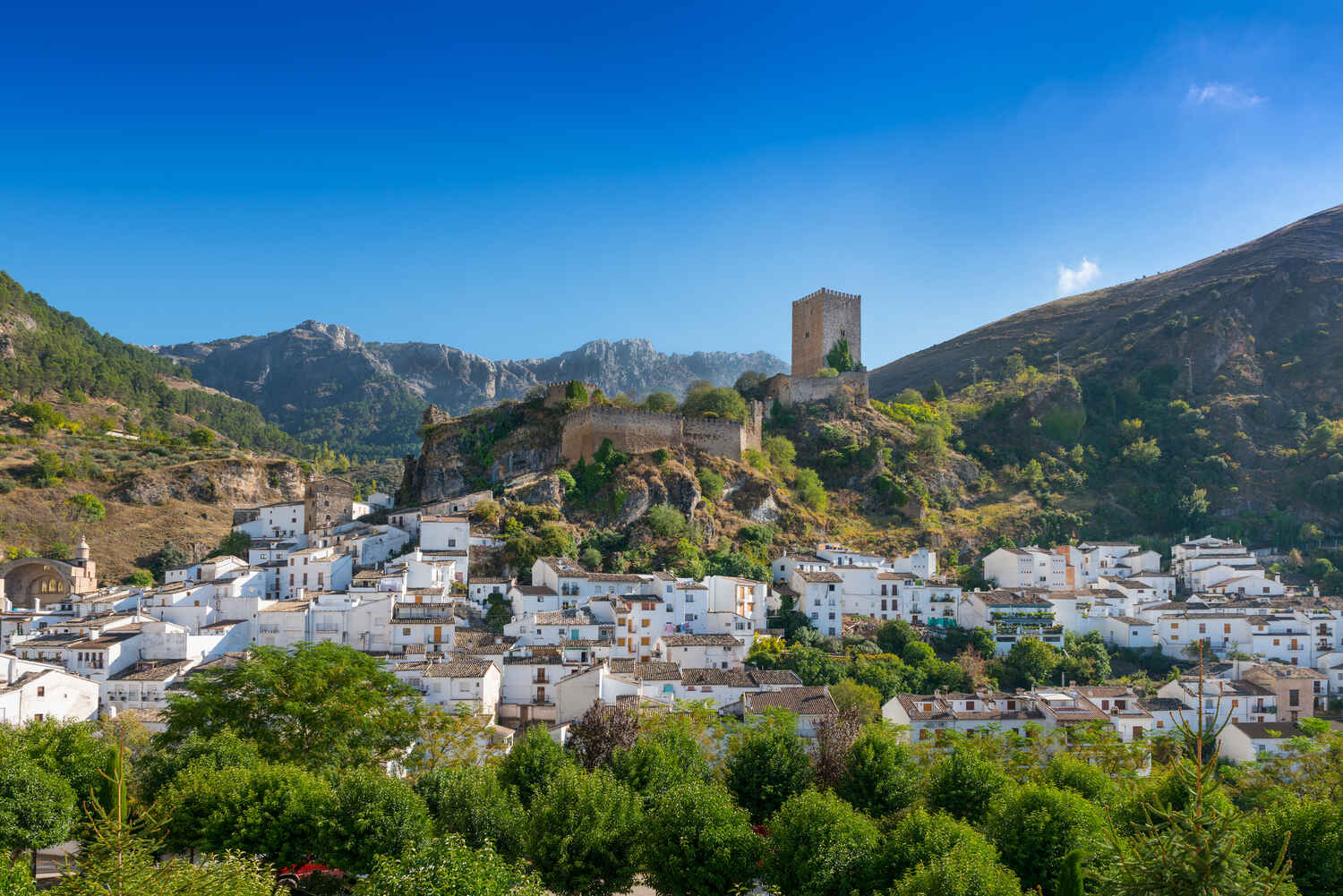
Castril, Granada
Castril, about 2.5 hours from Granada, offers a tranquil retreat with its stunning natural landscapes.
The Castril River walkway, a wooden path along the river’s edge, provides an exhilarating experience with its beautiful scenery. Explore the Peña de Castril, a striking rock formation that dominates the village.
The local museum, dedicated to the history and culture of Castril, is well worth a visit. Outdoor activities like kayaking and hiking are popular here, taking advantage of the area’s natural beauty.
Castril is a peaceful haven for those looking to connect with nature, and you guessed it, it’s one of the best white villages in Andalucia!
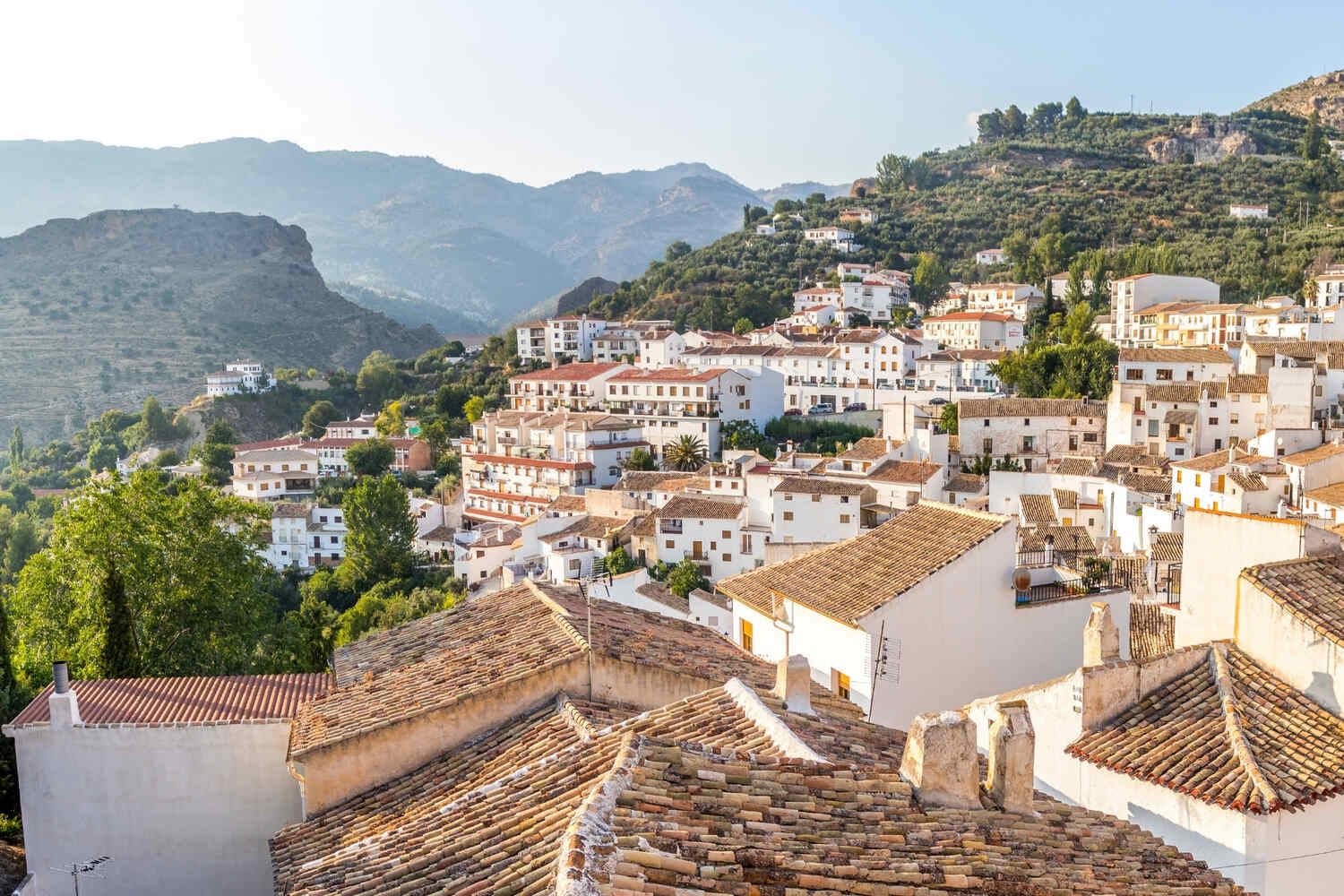
Guadix, Granada
Guadix, located about an hour from Granada, is famous for its cave dwellings in the Barrio de las Cuevas, offering a unique glimpse into an alternative way of living.
The Guadix Cathedral, blending Gothic, Baroque, and Neoclassical styles, dominates the town center. For a panoramic view of the town and its surroundings, head to the Alcazaba.
The local market is a great place to explore Andalusian cuisine and crafts. Guadix’s troglodyte heritage, combined with its rich history and culture, provides a fascinating visit.
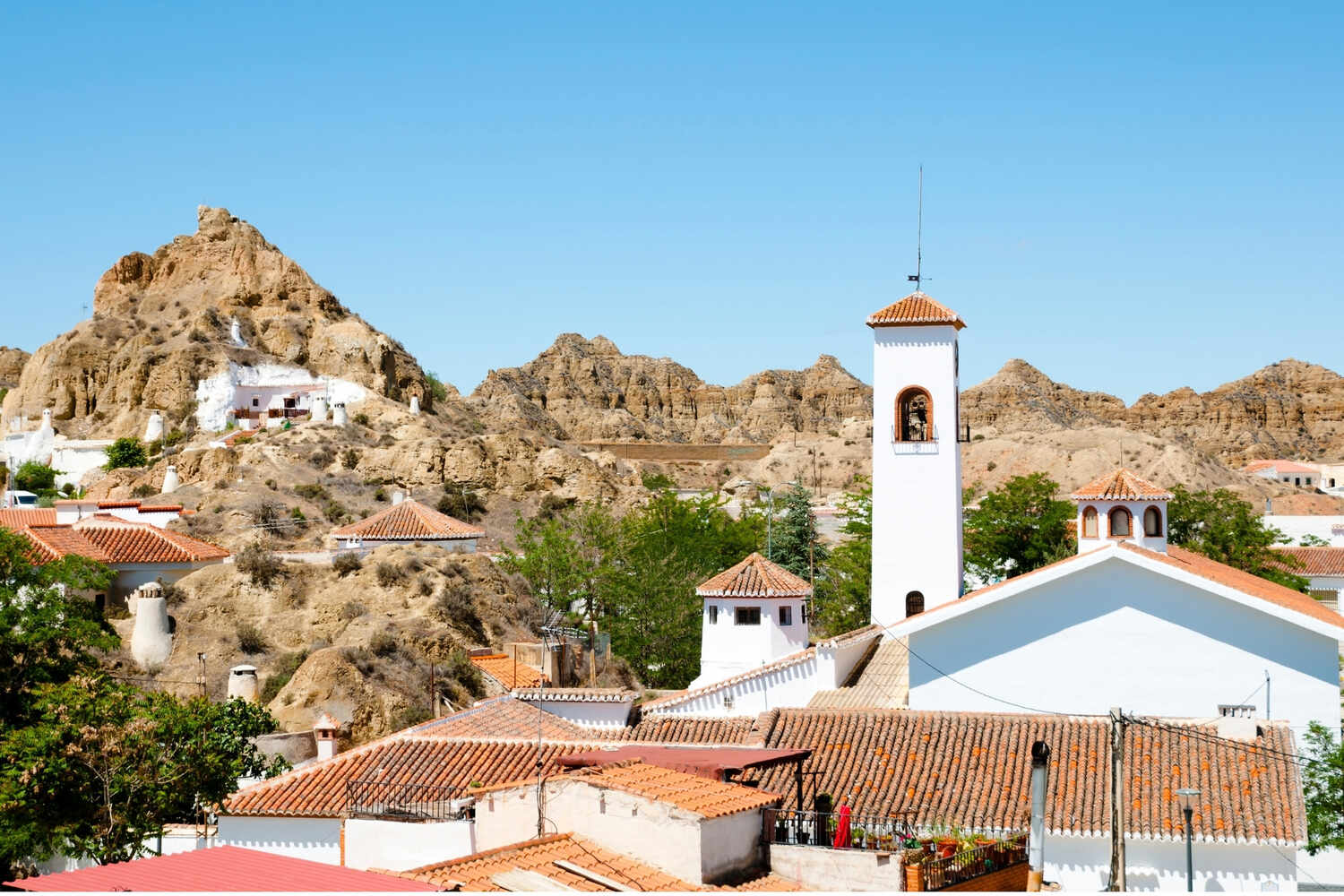
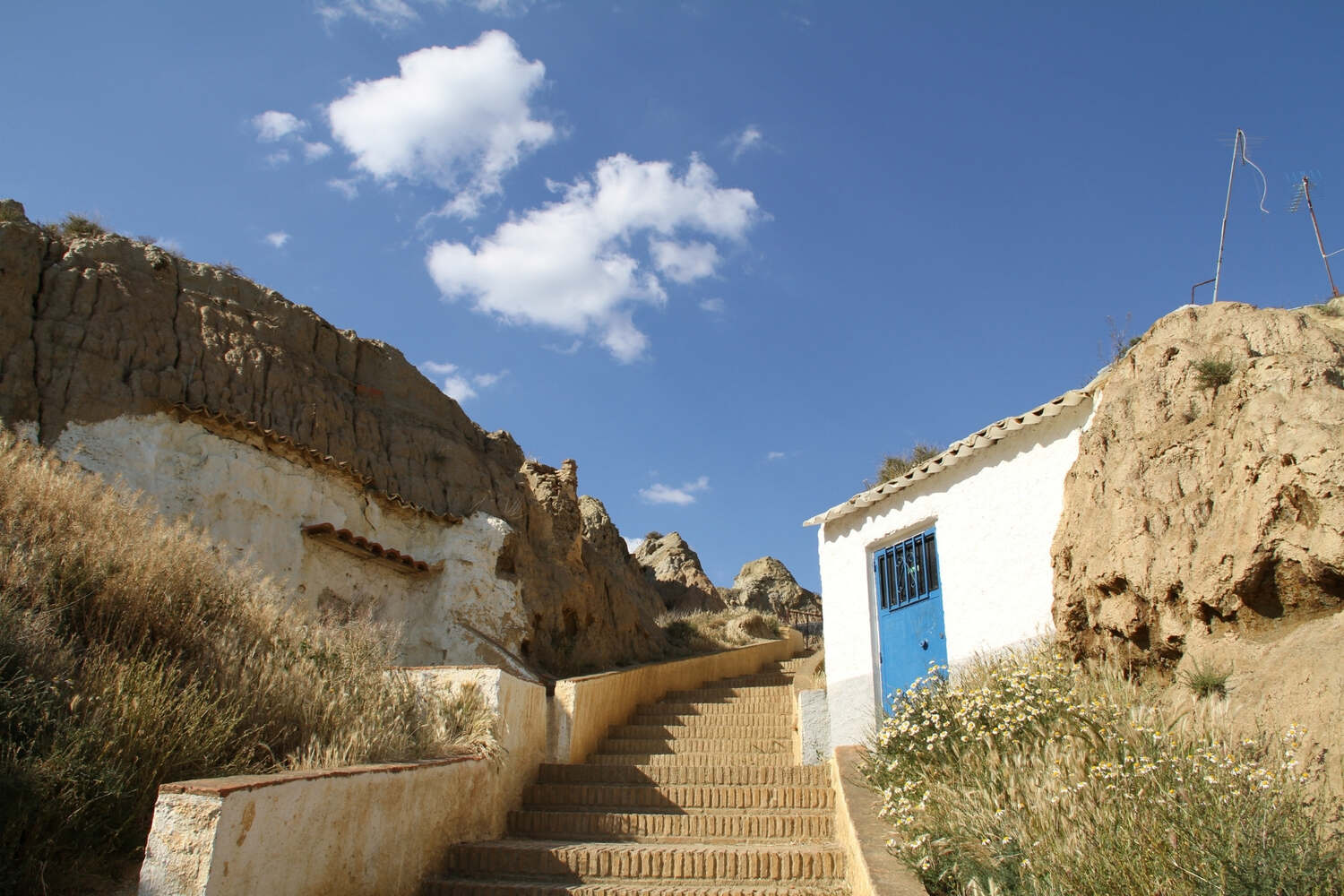
Iznajar, Granada
Iznajar, perched beside a vast reservoir and about 1.5 hours from Granada, is known as the “Mirador del Genil” for its stunning views of the surrounding water and countryside.
The Castillo de Iznajar offers history enthusiasts a look into the past with its well-preserved structure. Enjoy a day at the Valdearenas Beach, where you can swim, kayak, or simply relax by the water.
The village’s narrow streets are perfect for a leisurely stroll, leading to hidden plazas and cafes. Iznajar combines the charm of a traditional Andalusian village with the allure of lakeside living.
Note: Iznájar is situated in Cordoba province but is relatively close to the Granada border. For the purposes of this list, it’s included here as it’s near Granada as well.
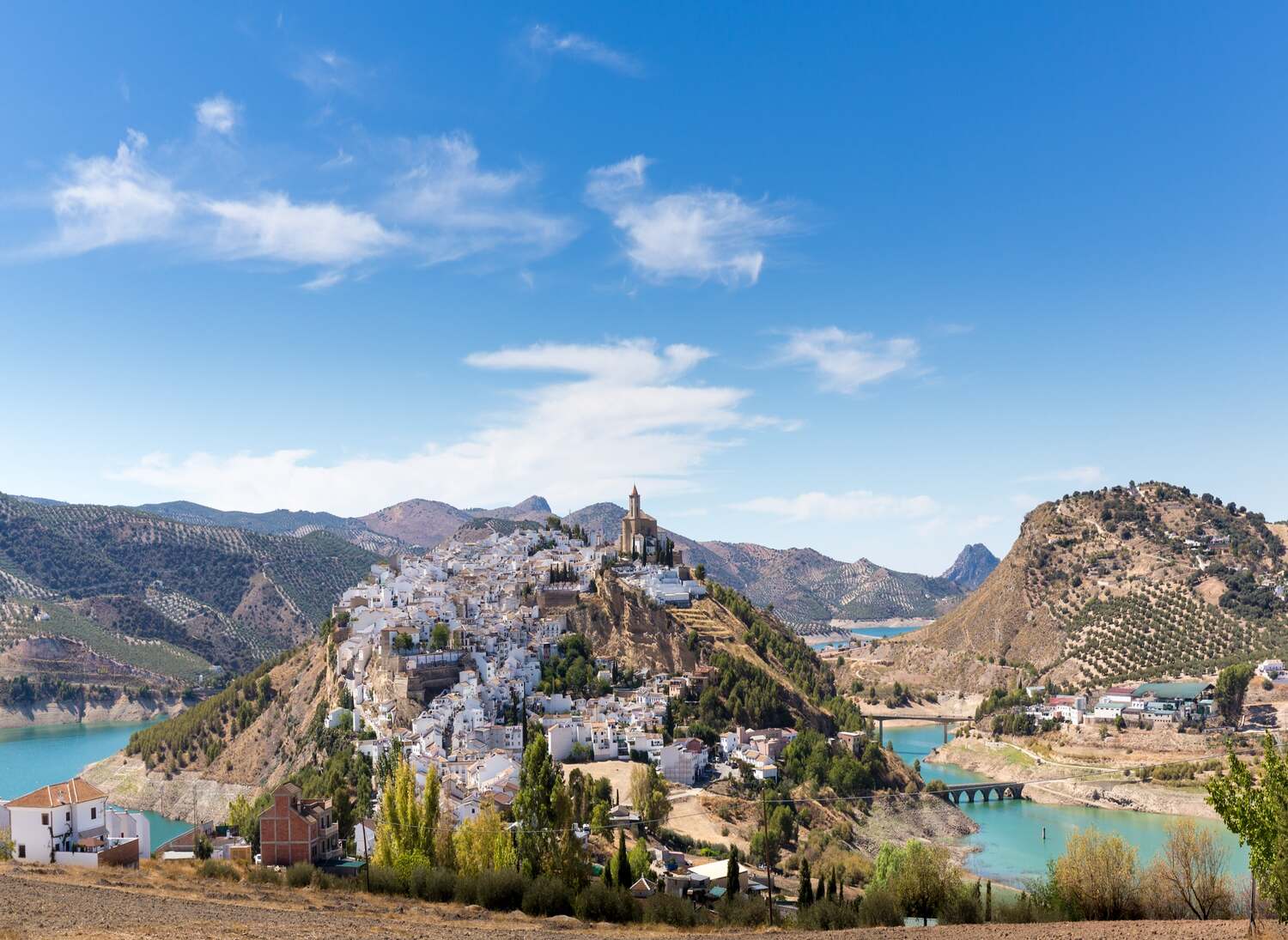
White Villages of Andalucia – FAQ
Now that we know everything about these Pueblos Blancos, and that you probably one some favorite one to add to your wishlist, let’s discuss some other topics that first-timers often have and I’m sure you’ll have too.
Why are the White Villages in Andalucia White?
The White Villages of Andalucia are painted white primarily for practical reasons: the white lime wash reflects the sun’s rays, helping to keep the interiors of buildings cool during the hot summer months.
This tradition dates back centuries, rooted in the region’s Moorish past, and serves both aesthetic and functional purposes.
The white facades also provide a striking contrast against the vibrant blue skies and green landscapes, enhancing their visual appeal and making these villages stand out in the Andalusian countryside.
What is the most Beautiful White Village?
While personal preferences vary, Mijas and Ronda are often celebrated as two of the most beautiful white villages in Andalucia. Mijas charms visitors with its coastal views, donkey taxis, and blooming flower pots adorning its narrow streets.
Ronda, with its dramatic position atop a deep gorge, offers breathtaking views and a rich history, including the iconic Puente Nuevo bridge. Both villages encapsulate the enchanting beauty of Andalucia, and they’re my personal favorite to visit.
What to Pack to Visit the White Villages in Andalucia?
When visiting the Pueblos Blancos in Andalucia, pack comfortable walking shoes to navigate the cobblestone streets and hilly terrain. A power bank is essential to keep your devices charged, as you’ll want to capture every moment.
Additionally, carry cash for transactions in more remote villages where card payments may not be accepted.
Also, don’t forget your camera, I’m sure you’ll take hundreds of photos when visiting the white villages in Southern Spain!
Conclusion: White Villages on Andalusia
Wrapping up our journey through Andalusia’s Pueblos Blancos, it’s clear these spots are more than just pretty places. They’re where history, culture, and stunning views come together, offering a slice of Spanish life that’s hard to find anywhere else.
From Malaga’s sunny shores to the historic vibes of Cadiz, and the peaceful countryside near Cordoba, Granada, and Jaen, each village tells its own story.
These villages are a must-visit for anyone wanting to dive deep into the heart of Andalusia, and I hope this guide was helpful to plan your next trip to stunning Andalusia!

